Last Updated on: 14th November 2024, 10:46 pm
Just outside of Turkey’s summer tourism capital Antalya is a wholly unique and often overlooked archaeological site. Termessos, built at over 1,000 meters above sea level, was just one of two Anatolian cities that Alexander the Great failed to conquer. Largely untouched and unexcavated since its abandonment, Termessos makes for a challenging yet highly rewarding day trip.
Termessos was part of the ancient kingdom of Pisidia, which bordered Lycia and Pamphylia in antiquity. Its origins are unclear, but the first mention of it was in Homer’s Iliad. According to Greek mythology, the city was conquered at some point by the hero Bellerophon as he rode atop Pegasus.
A flying horse was apparently the only way for one to conquer such a city. Termessos managed to function autonomously for most of its history, though it was briefly taken by the Ptolemies after Alexander’s death.
The Termessians later formed an alliance with King Attalus II of Pergamon, the founder of modern-day Antalya. And even after the Romans took over the region, Termessos was largely left alone. Only a massive earthquake in the 5th century AD would cause residents to flee for good.
Termessos is relatively well-preserved, while the ancient city’s mountaintop setting is unmatched. But due to its high altitude, Termessos is tricky to reach, especially without your own car.
As we’ll cover over below, walking all the way up the mountain is an option, though not recommended for most. Check the end of the article for more details on transport and general visiting tips.

Up the Mountain
Termessos lies just about 17 km northwest of central Antalya, and buses bound for the city of Korkuteli can drop you off along the highway. From there, the official ticket booth for Termessos Ancient City is just minutes away.
The problem is, however, that there are no less than nine kilometers separating the ticket booth from the hilltop ruins! Without your own car, there are only two options: hire a taxi or walk. (Though you could also attempt to hitchhike).
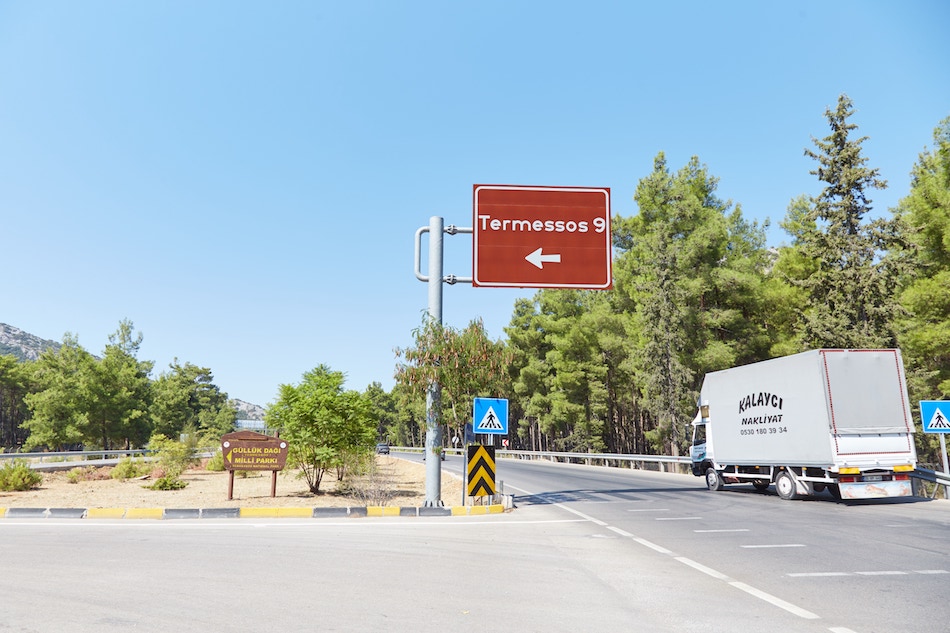
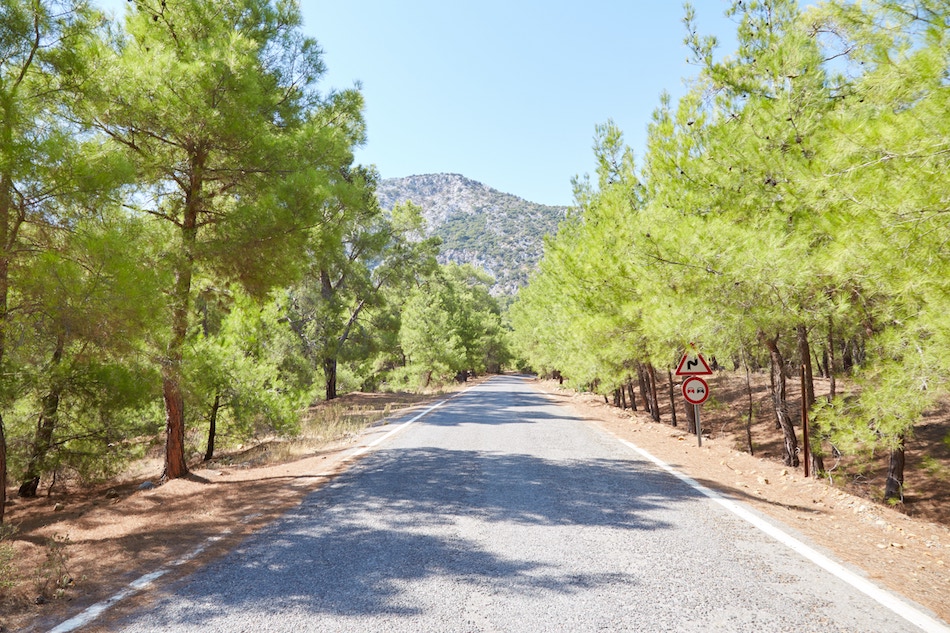
I’d read online that the taxi drivers here are a hard bunch to deal with. Though I’d considered negotiating with them, I was enjoying the fresh air after the cramped bus ride over. And so I decided to save some money and make the long walk up to the Eagle’s Nest on my own two feet.
The Eagle’s Nest moniker was coined by none other than Alexander the Great, who made his way through here in the 4th century BC. As mentioned above, it’s one of just two Anatolian cities (along with Sillyon) that he failed to conquer.
Some scholars believe he tried and failed to breach the city walls, while others say he simply didn’t bother.

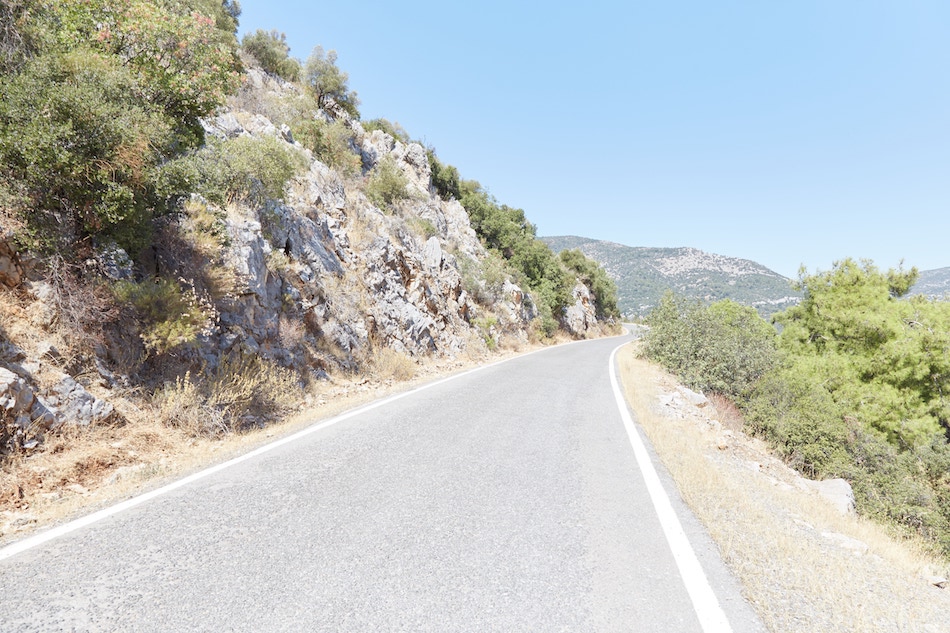
And as I walked and walked, I began to get a sense of what may have been going through Alexander’s mind. While the scenery was beautiful, 9 km uphill is no easy start to the day.
I was walking along Kings Road, the ancient road that lead right to the city center. It’s still lined with small ruins on either side, most of which date back to the 2nd century AD.
The ancient highway also extends through the Yenice pass – the same pass Alexander the Great attempted to traverse on his way to Phrygia.

Thankfully, the slope remained relatively gentle throughout the walk. My main concern, though, was time. Despite getting an early start, I began to doubt if I’d really be able to walk up, see everything, and make the long walk back down before sunset.
But my fears were soon abated. About 60% through with the walk, a car pulled over next to me. I’d encountered hardly any cars until that point, but it turned out to be a helpful staff member who was on his way to work.
I arrived at the site around 12:30 – a little earlier than expected.
Around the Base
The main parking area is situated beneath the ancient city walls, and some more uphill walking is required to reach the main site.
But before heading up, there are a few interesting structures to check out around the base.
The most noteworthy is Hadrian’s Temple, an emperor who also had constructions named after him in central Antalya.
Built in the Ionic order, only the entrance gate and a few preserved arches remain standing. Judging from the amount of rubble strewn about, it was probably once quite large.
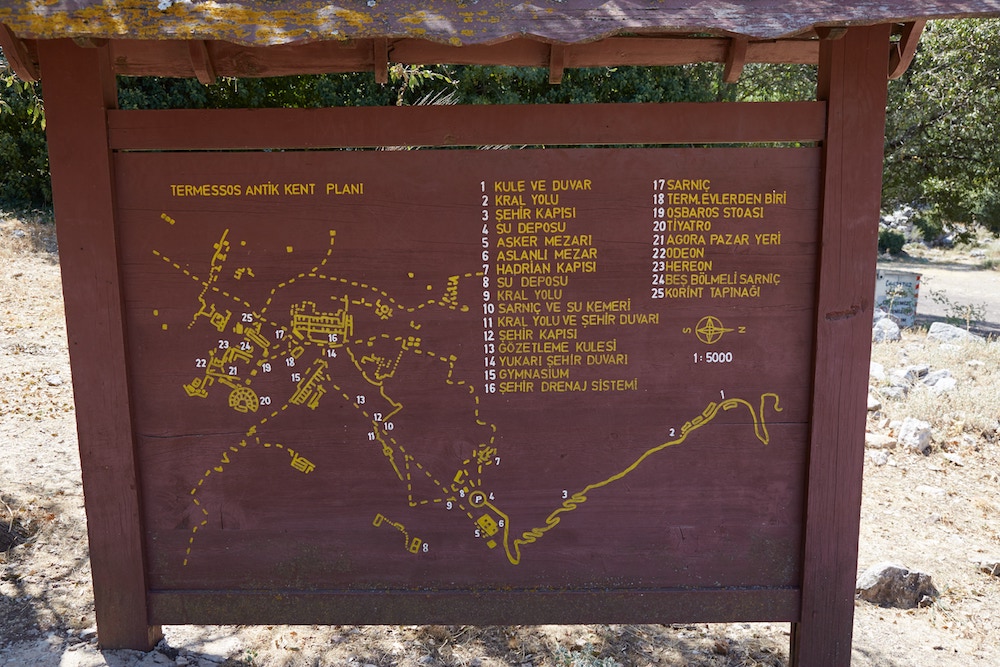
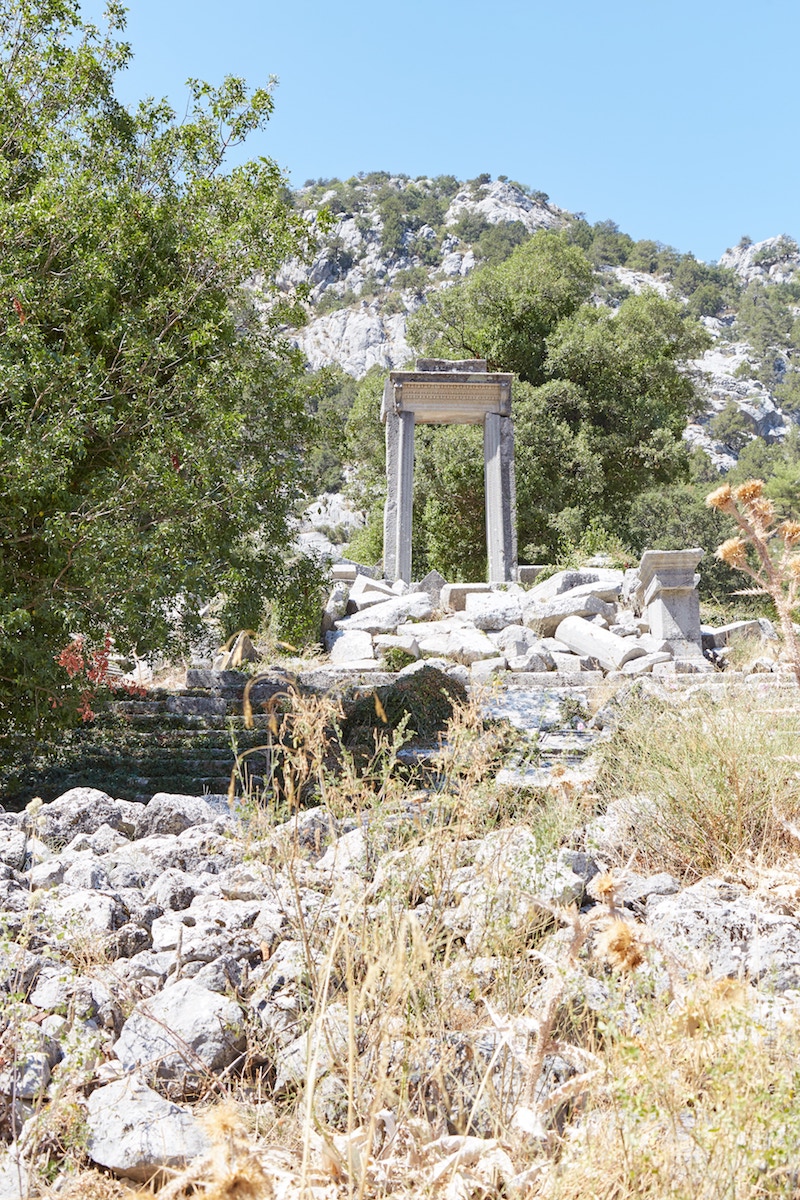
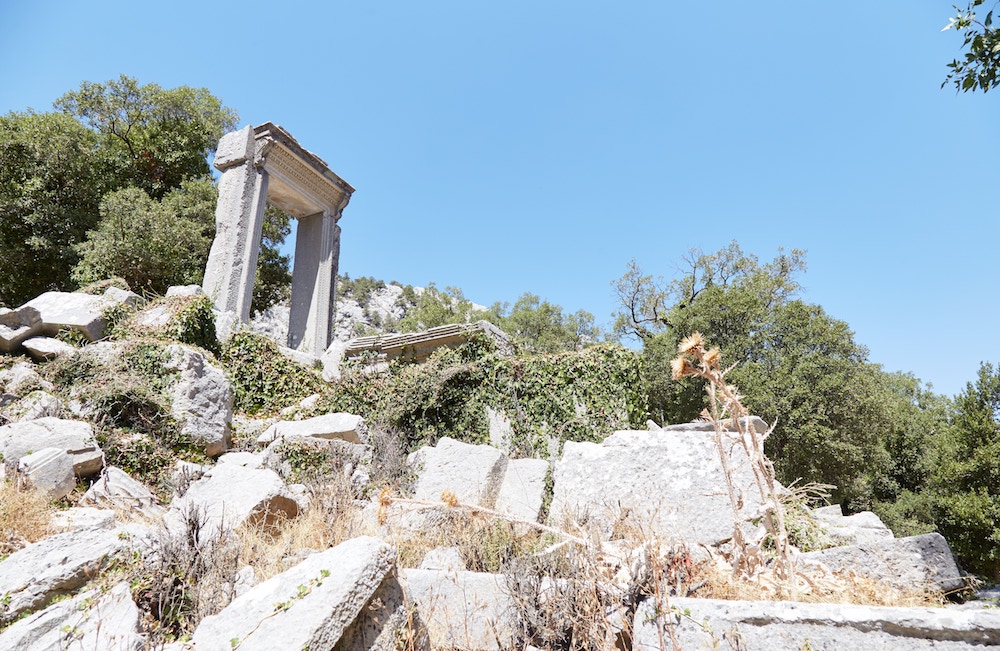

Over on the opposite side, meanwhile, is the southeast necropolis. Here you’ll find many sarcophagi lying on the ground. But as we’ll go over shortly, there are a few additional necropolises higher up that are surrounded by stunning scenery.


Note that there are two ways up to central Termessos. One is via a path near Hadrian’s Temple, while the other starts near the ancient water tank. I took the latter path, while I exited Termessos the other way.
Be sure to download Maps.me before your visit, as it has all the trails and landmarks clearly marked.


As you make your way up the forested trail, you’ll eventually encounter a large and smooth wall which marked the lower boundary of central Termesssos.
While hardly apparent to the casual visitor, some faint inscriptions on the walls indicate that divination ceremonies once took place here.

Continuing past the walls and the ruined entrance gate – you’ll find yourself within Termessos proper.
Termessos is quite a large site that takes at least a few hours to thoroughly explore. While there are a number of different ways to go about it, I started by turning left to check out the gymnasium and bath.
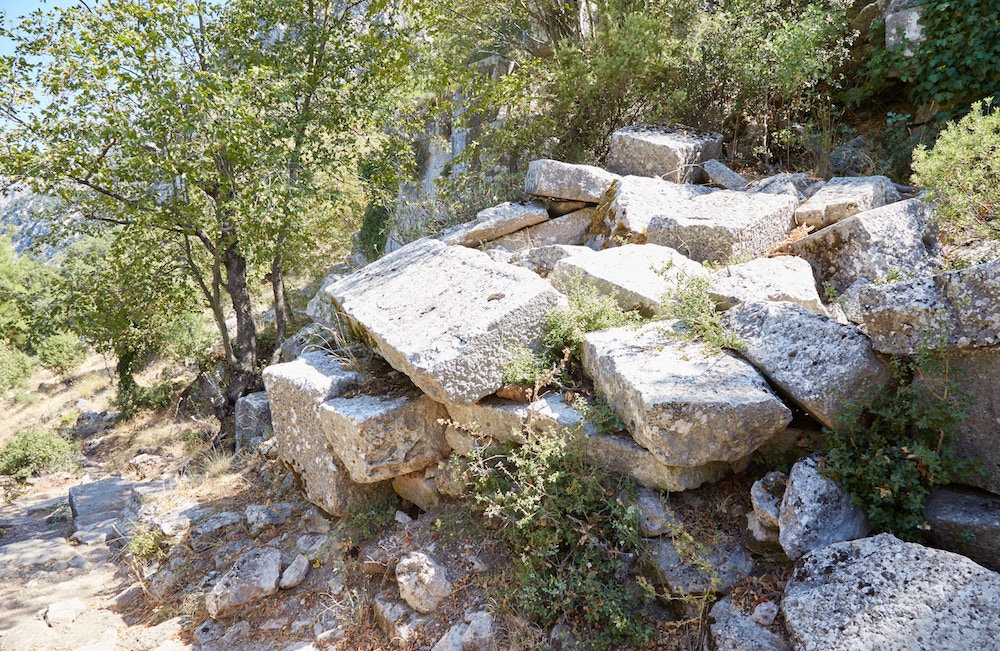

The Gymnasium, Bath & Viewpoint
Not unlike our modern idea of the gym, gymnasiums of the Greco-Roman world were athletic training centers, albeit for men only.
And after long training sessions, which were all done in the nude, athletes needed to rinse off all the sweat and grime. As such, gymnasiums were also typically home to bathhouses.
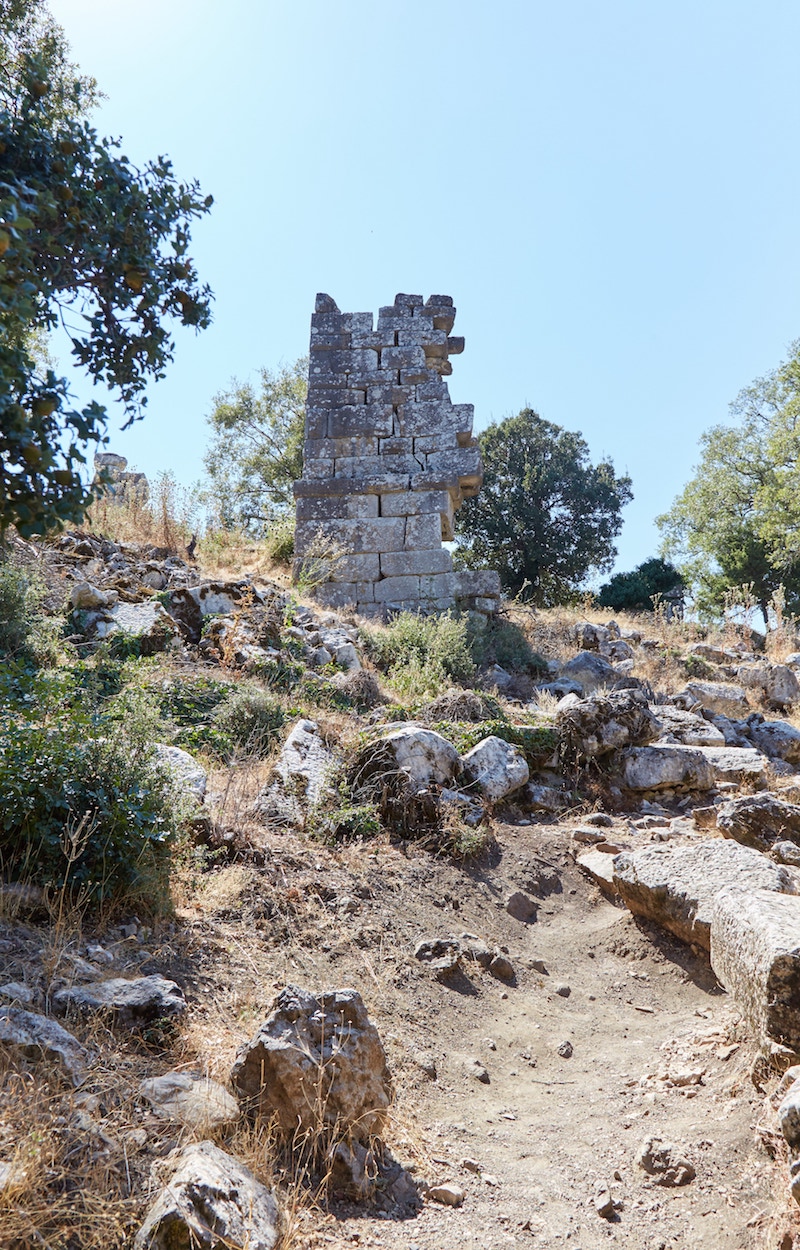

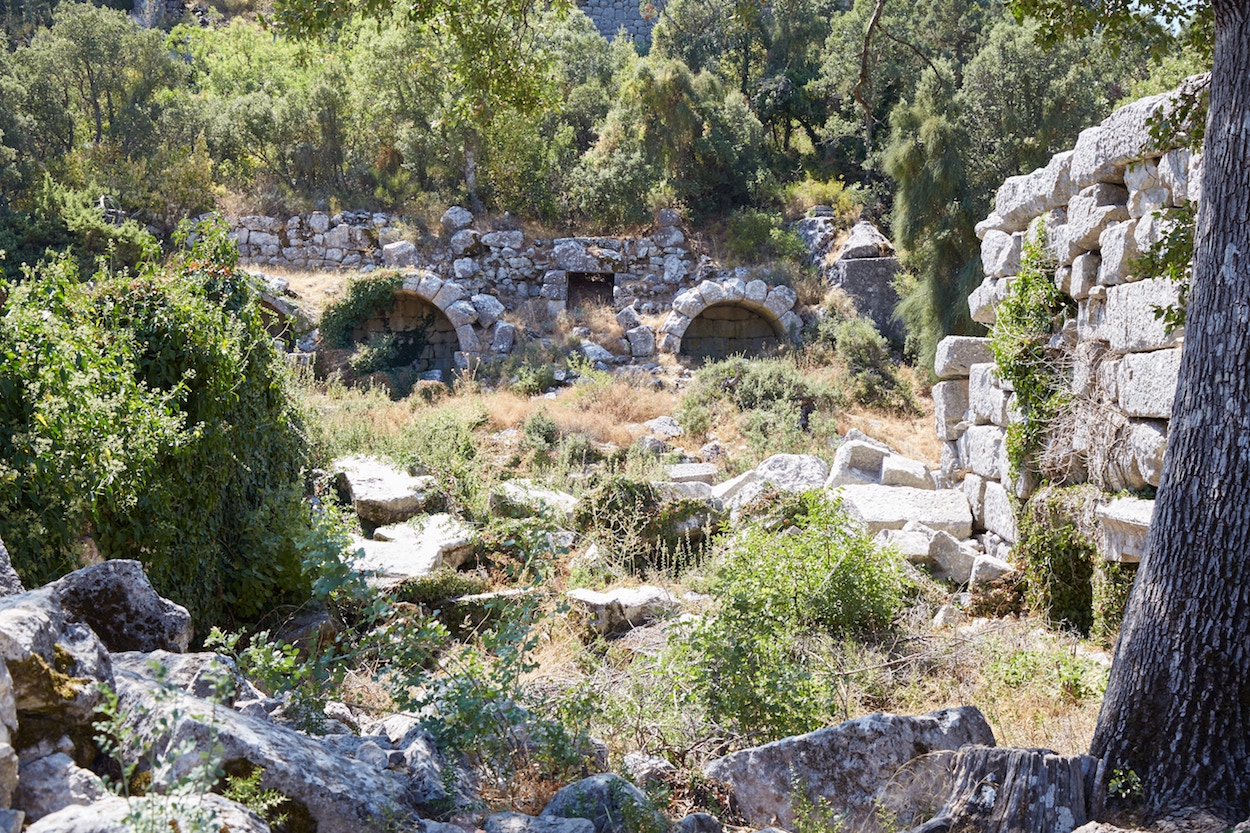
Aside from some simple signs with the name of each area, you won’t find any historical or architectural information around Termessos. In fact, we don’t know a whole lot about this site in general, as there have yet to be any proper archaeological excavations.
While some European researchers examined the ruins in the 19th century, what visitors see today is pretty much how Termessos has looked since its abandonment centuries ago.
Future excavations will hopefully reveal more about life at the ancient city. Termessos’s raw, untouched appearance, however, is a big part of its current appeal.
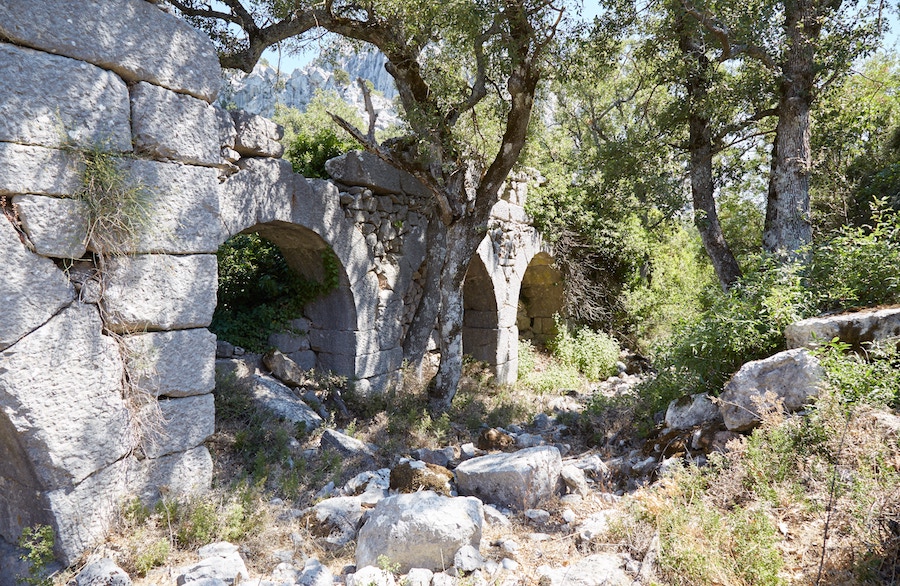
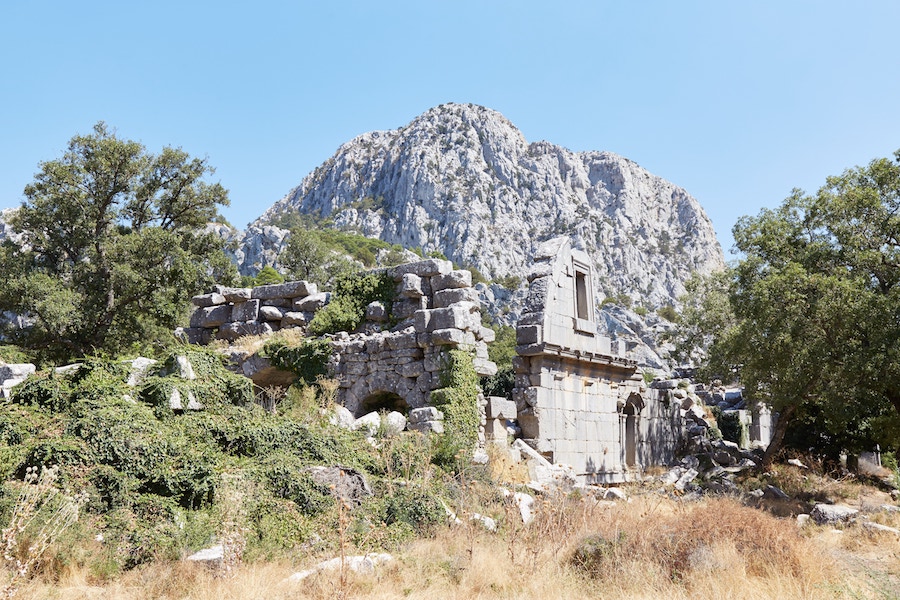
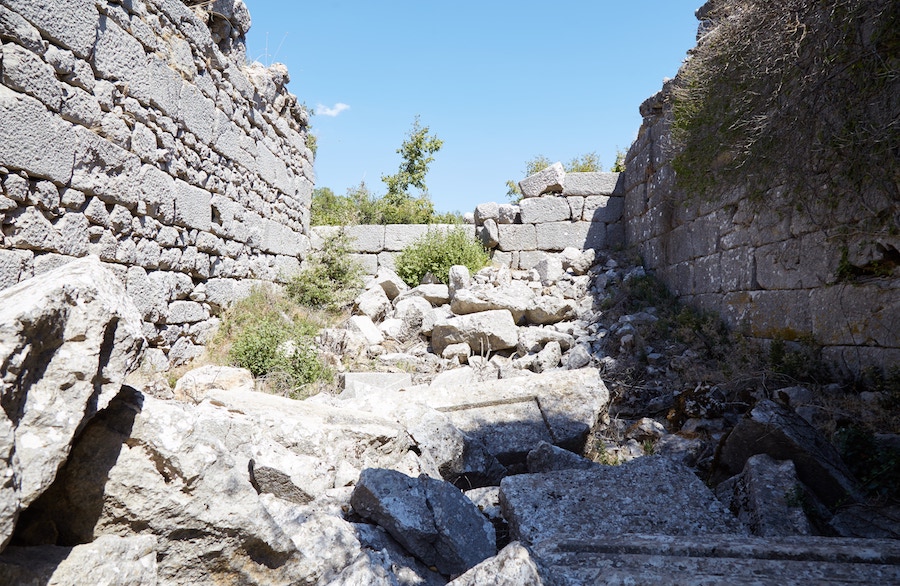
The gymnasium area is home to numerous well-preserved buildings that are a lot of fun to explore. Several of them are climbable, letting you take in views of the wider area from the second story.
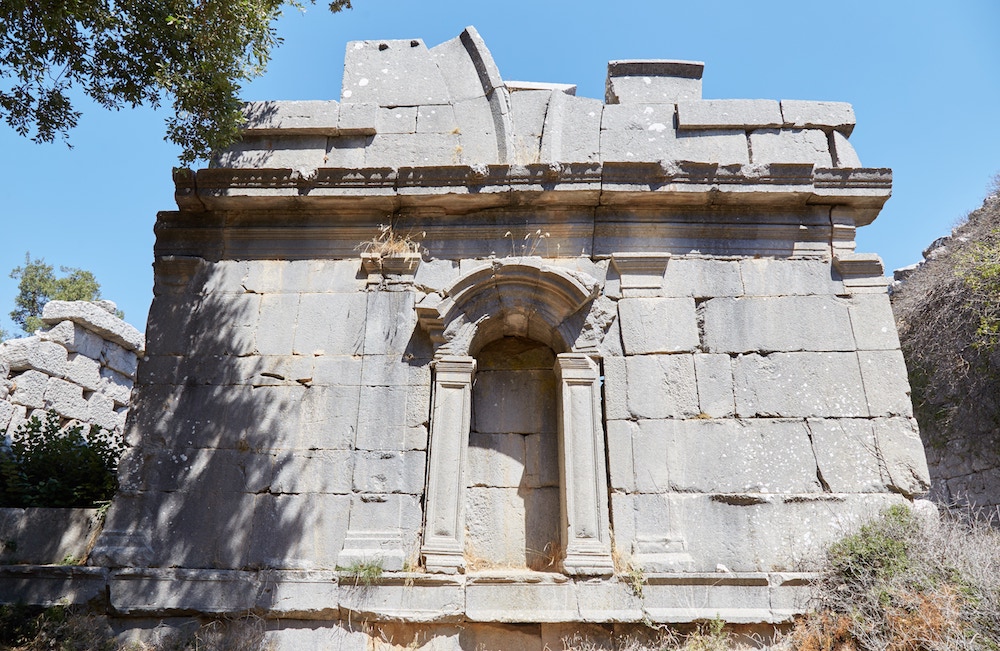
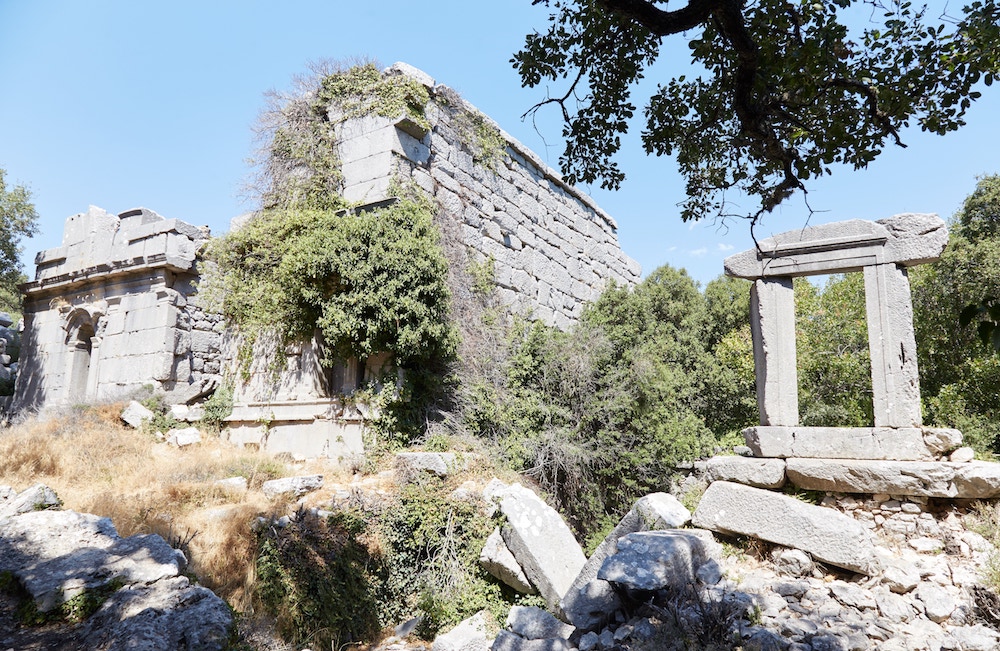
Reaching the last of the buildings near the edge of the forest, I noticed that Maps.me had a scenic viewpoint marked much deeper within. And despite the forest appearing rough and overgrown, I was unable to resist my curiosity.
After several minutes of walking, I wasn’t quite sure what I was supposed to find. But looking through a gap between the trees, I spotted a large stone sarcophagus up in the distance.
This wasn’t just a scenic viewpoint offering great views of the Taurus mountain range, but one of Termessos’s several ancient necropolises!
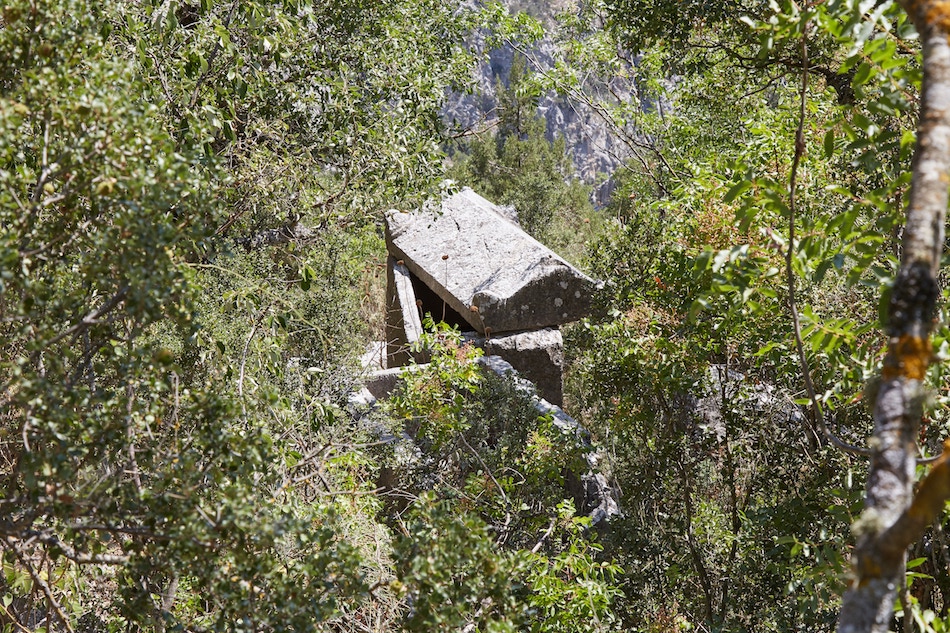
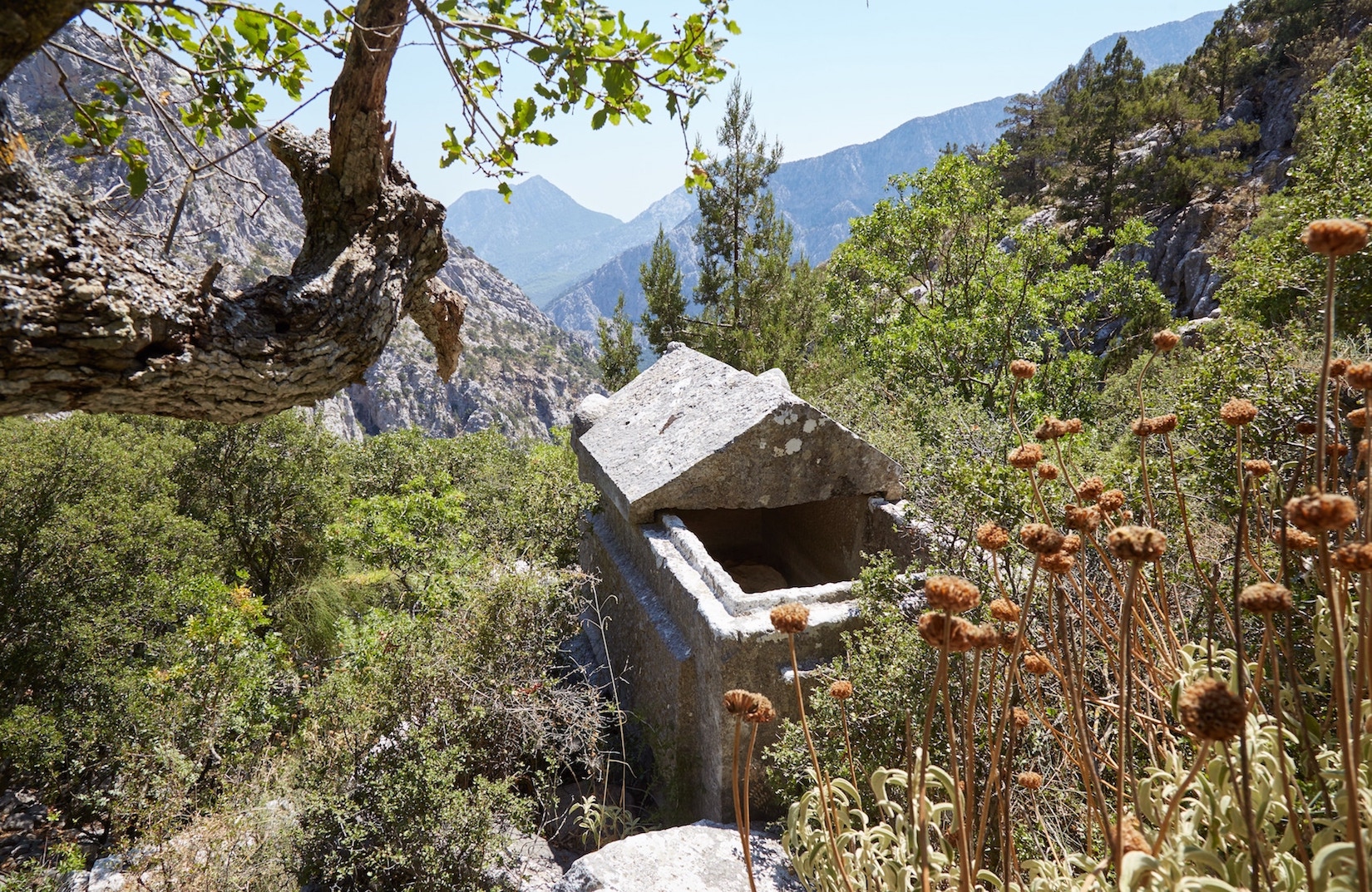
I took my time enjoying the views and observing the stone boxes from up close. But when it was time to head back to the gymnasium, I encountered a problem.
Having walked around to check out the various sarcophagi, I’d lost the trail back. Despite my best efforts, I simply couldn’t locate it. I did, at least, know which direction I needed to head.
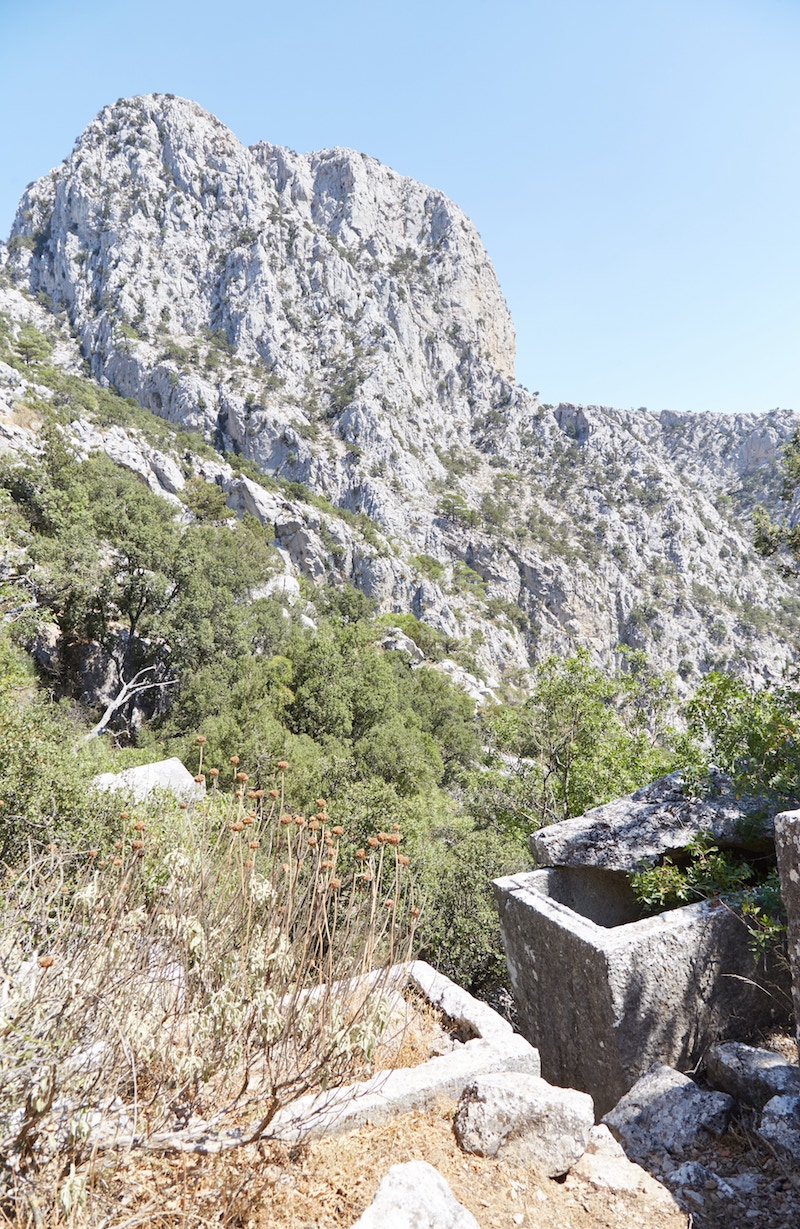

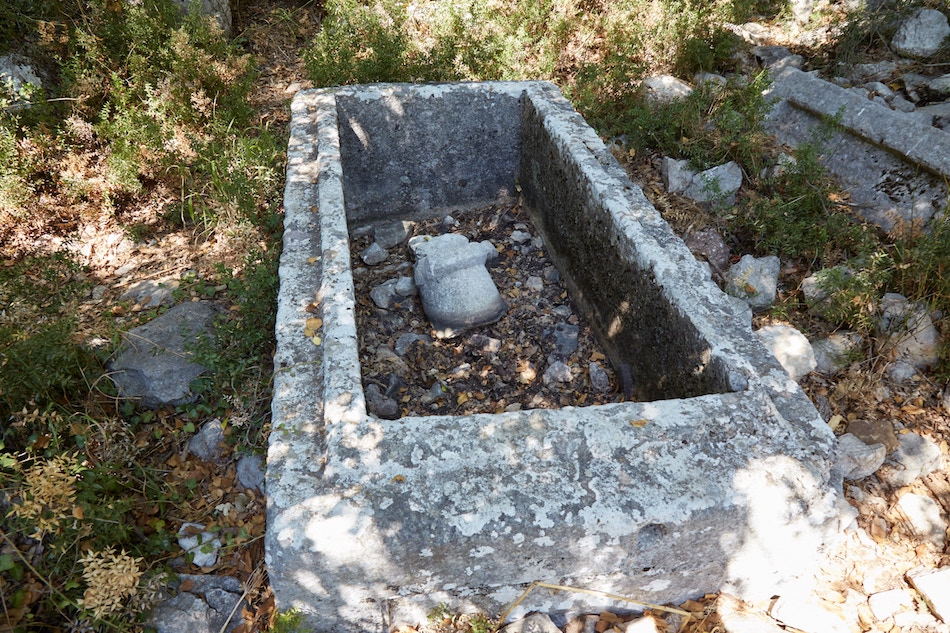
I continued ahead, crawling through the thick overgrowth and breaking off branches to clear new openings. I slipped several times and got pretty scratched up, but I did eventually make it.
Now knowing that the southeast necropolis (see below) offers even better views, I’d recommend you skip this viewpoint and save your energy for later.
Toward the Theater

Back through the gymnasium and toward the main square, you’ll find the upper city walls – still looking sturdy and solid after all these years.
You’ll then spot the large colonnaded street area in the distance, but it’s best to save it for later. That area leads directly to the alternate exit you can take on the way out.
Heading toward the theater, you’ll pass by the flooring of a stoa placed by a wealthy man named Osbaras,
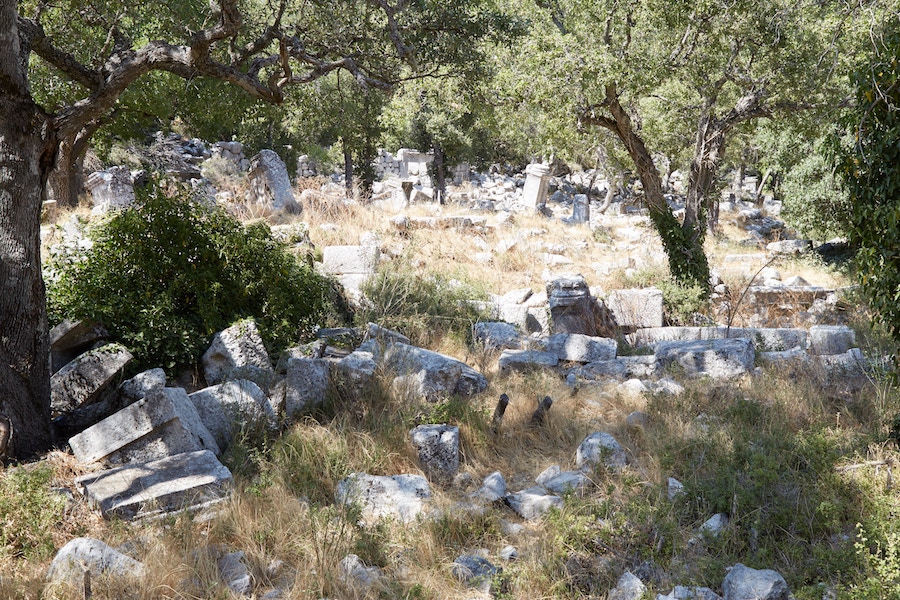

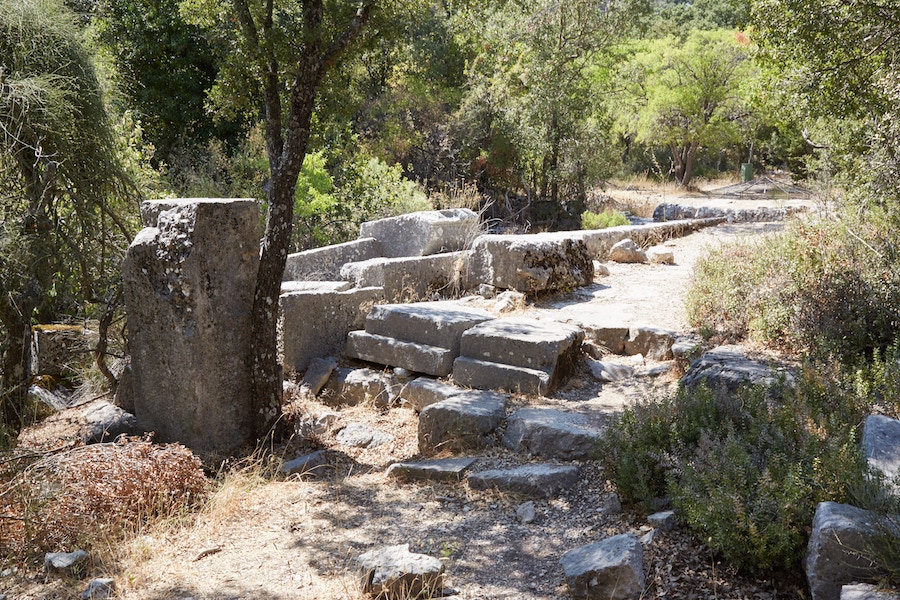
Continuing southeast along the trail, you’ll soon come to face to face with Termessos Theater – arguably one of the most breathtaking settings for a Greco-Roman theater in the world.
While littered with rubble, the seating area remains largely intact. It’s still easy to imagine how it would’ve been to witness a performance with the towering travertine mountain in the background.

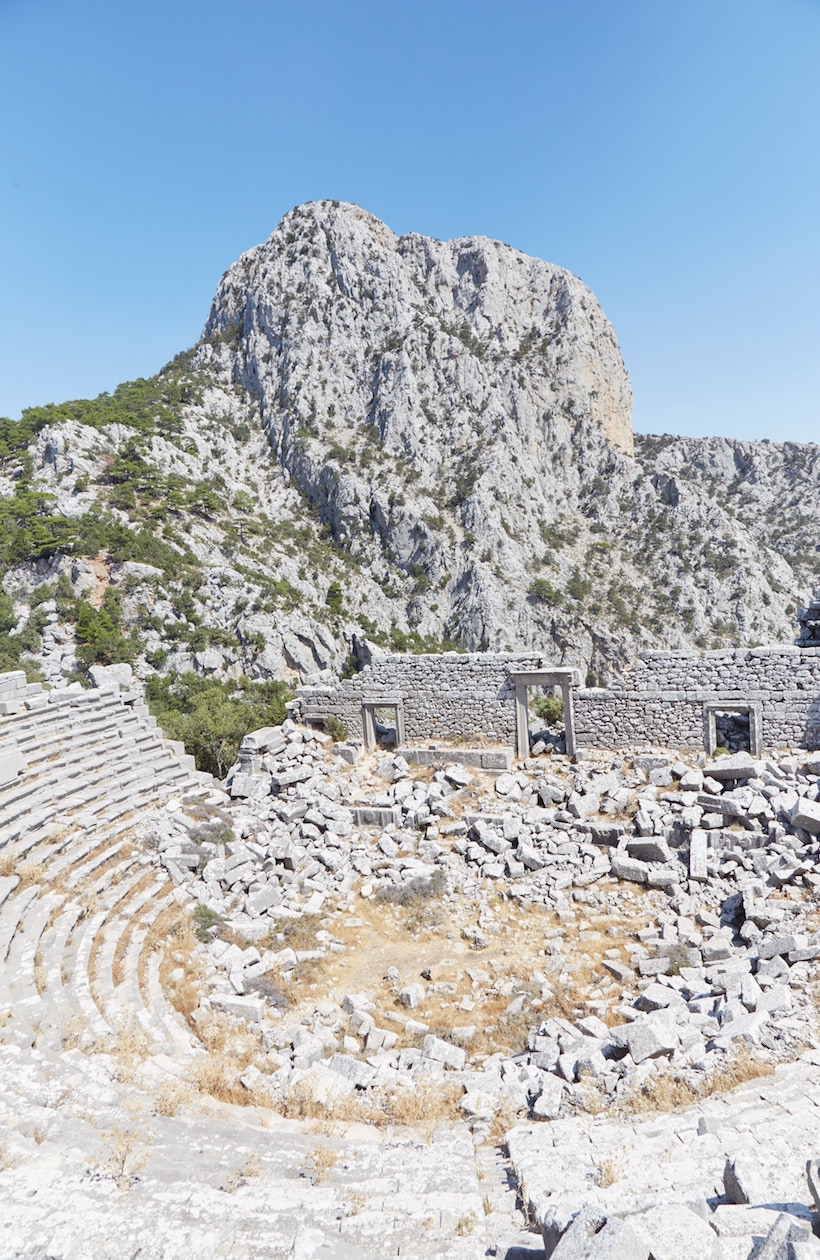

Originally built in the Hellenistic era, the theater was later renovated during the Roman period. In total, it could fit several thousand spectators.
While many of Turkey’s better-known theaters have been recently restored, they now have a rather artificial feel to them. Everything you see at Termessos Theater, in contrast, is wholly original. It’s arguably the highlight of the entire archaeological site.
Though much has been destroyed, the tall stage walls and parts of the backstage area remain in surprisingly good condition.
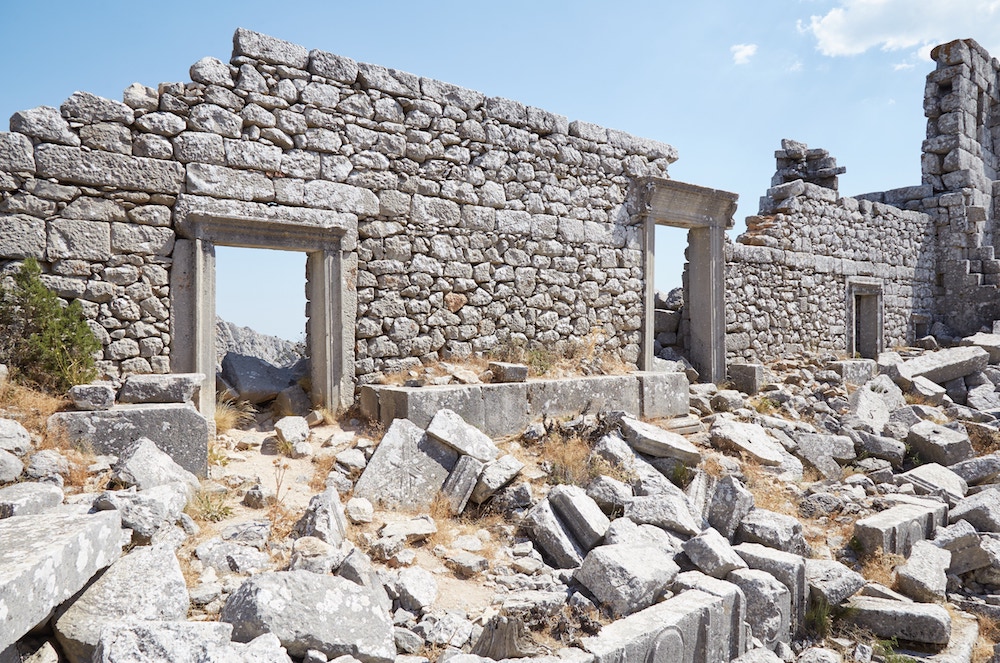

Around the Agora
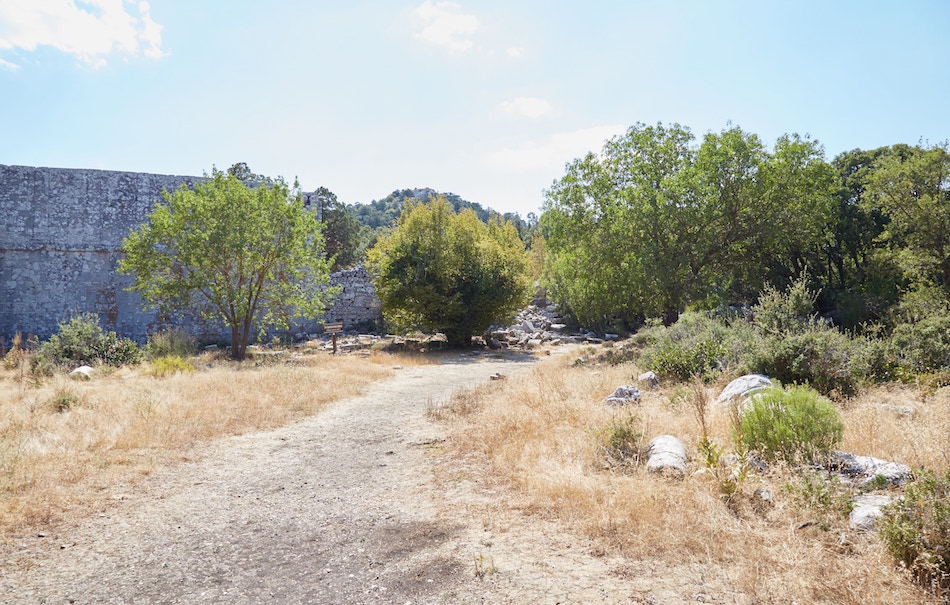
Now it’s time to explore the area around the agora. Not far from the theater, you’ll encounter a well-preserved structure with 10-meter high walls that functioned as an Odeon.
Odeons were smaller theater-like buildings reserved for poetry readings or more intimate musical performances. They contained similar circular seating arrangements, though the ones here are obscured by overgrowth and rubble.
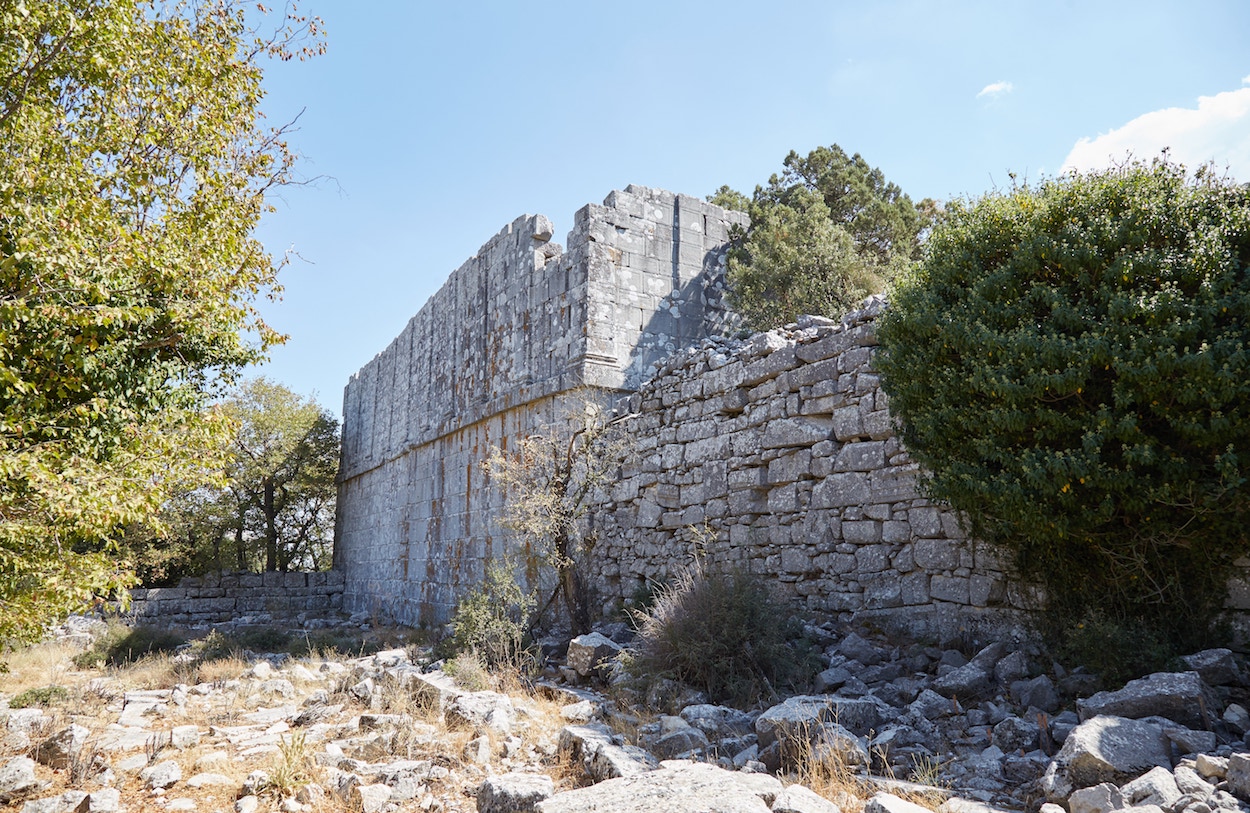

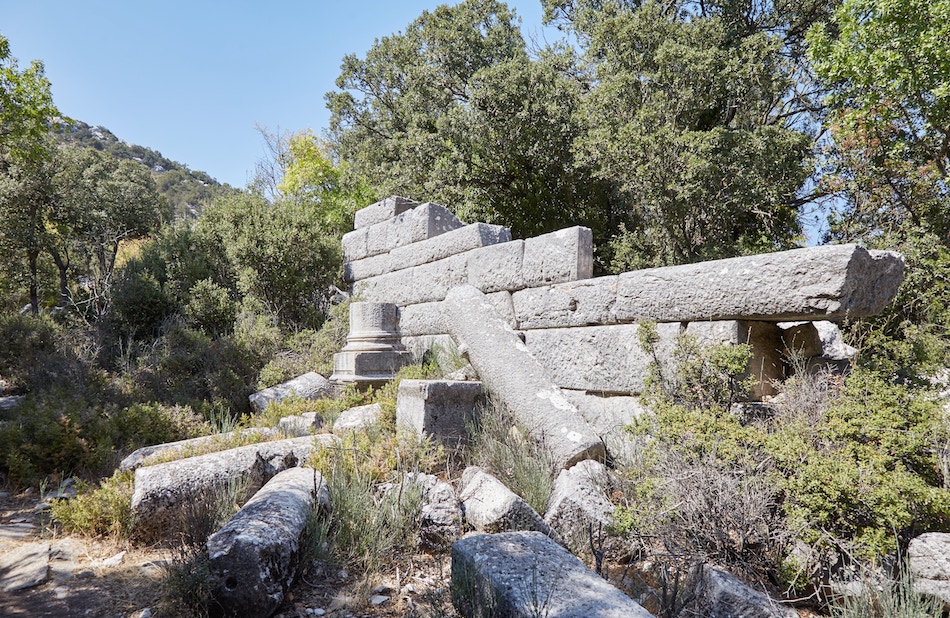
Just next to it, meanwhile, are the ruins of a few other structures believed to be temples. One was likely a temple dedicated to Artemis.
And another to Zeus-Solymeus – the main deity worshipped at Thermessos. As the name suggests, he was a fusion of the prominent Greek god with his native Anatolian counterpart.



Moving on, you’ll pass the remnants of the ancient cisterns marked by several holes in the ground. There’s also a ruined structure called the ‘Benefactor’s House.’ While an inscription labels him as Thermessos’s founder, the building likely dates to Roman times.
Also around the area are the ruins of a former two-storied stoa established by Attalos II, king of Pergamon. This is the same king who established the city we now call Antalya. As mentioned above, Termessos and Pergamon were allies.
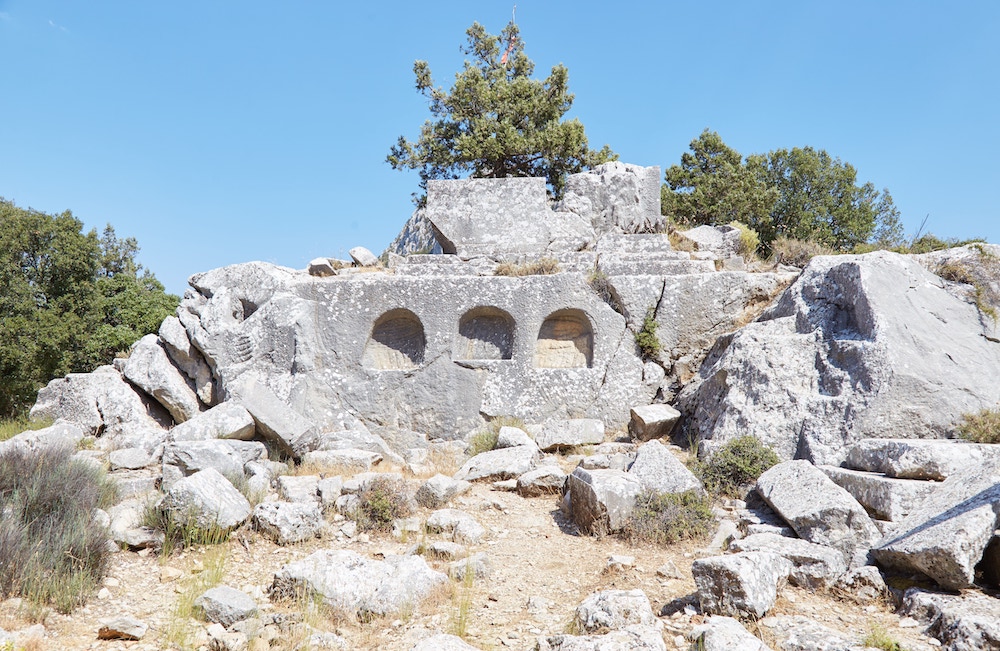

One of the most unique structures around here is a tomb belonging to a distinguished warrior. Notably, he was buried right in the city center rather than within a designated necropolis. The identity of the deceased, however, remains a mystery.
A bit further west is what’s known as the ‘Corinth Temple.’ While built in the Corinthian architectural style, we don’t know which deity was worshipped here.
The Tomb of Alcetas
A bit further west, you’ll reach a crossroads with two separate uphill paths to choose from. Both are absolutely worth checking out, but I started off with the Tomb of Alcetas.
After walking for 10-15 minutes uphill, you’ll come face to face with the most elaborate tomb in all of Termessos.

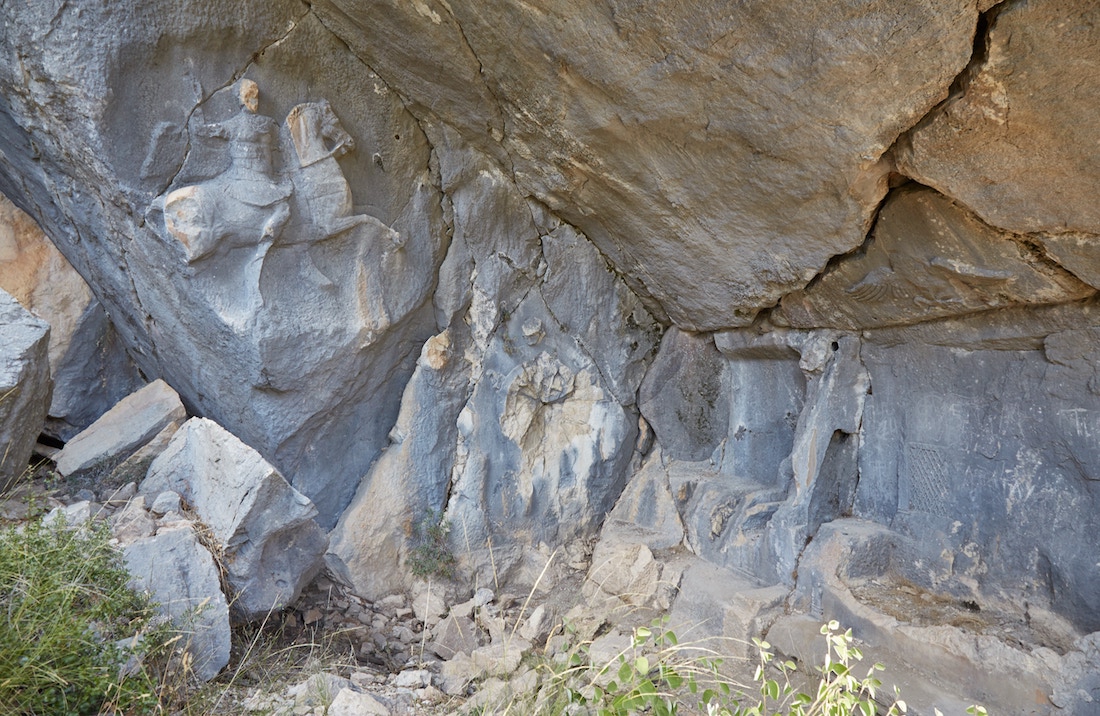
Following Alexander the Great’s death, Termessos was caught in a dispute between two of his generals, Antigonos and Alcetas, who both wanted control over all of Asia Minor.
Confronted with Antigonos and his men, Alcetas took refuge in Termessos. While the elders promised his safety, they soon found themselves fending off an attack by Antigonos.
Realizing the whole situation was much more trouble than they’d bargained for, the elders went back on their word and decided to hand Alcetas over to his rival. Refusing to be taken alive, Alcetas committed suicide.
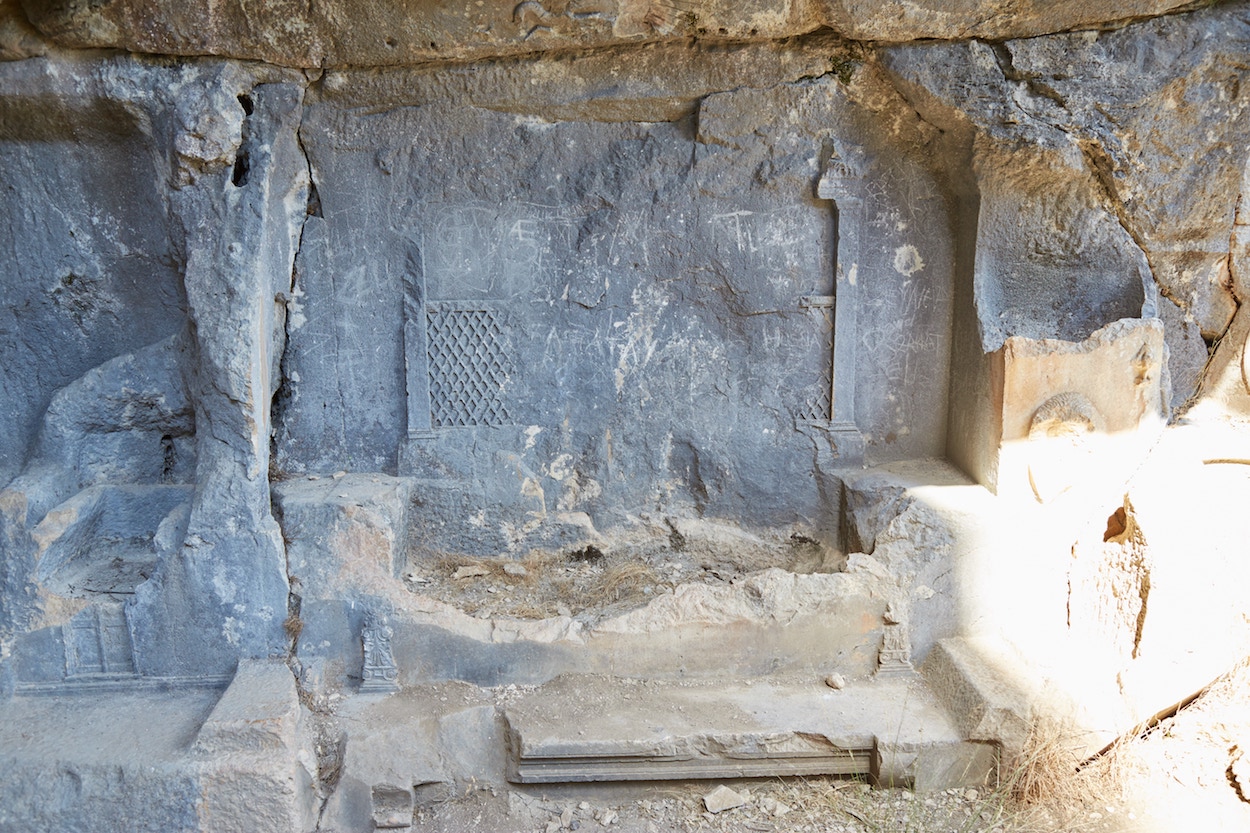
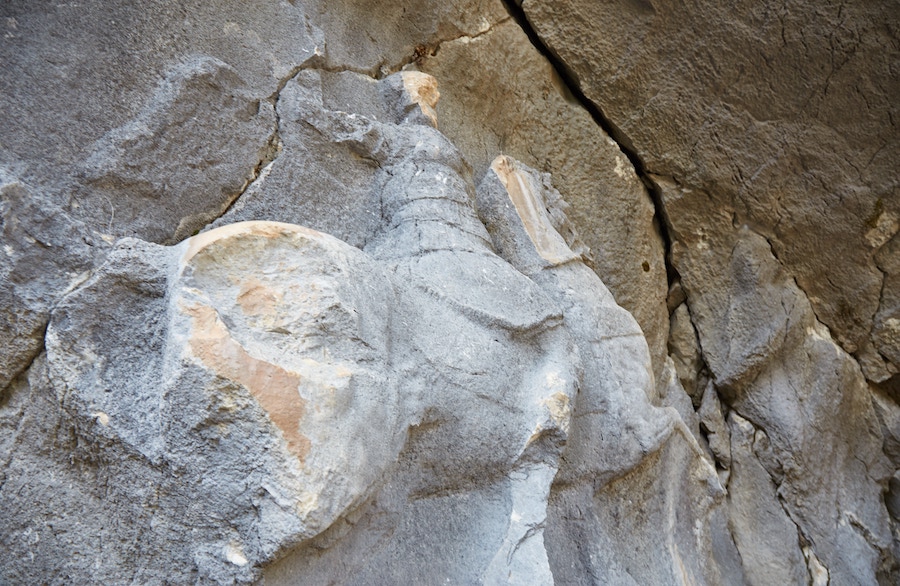
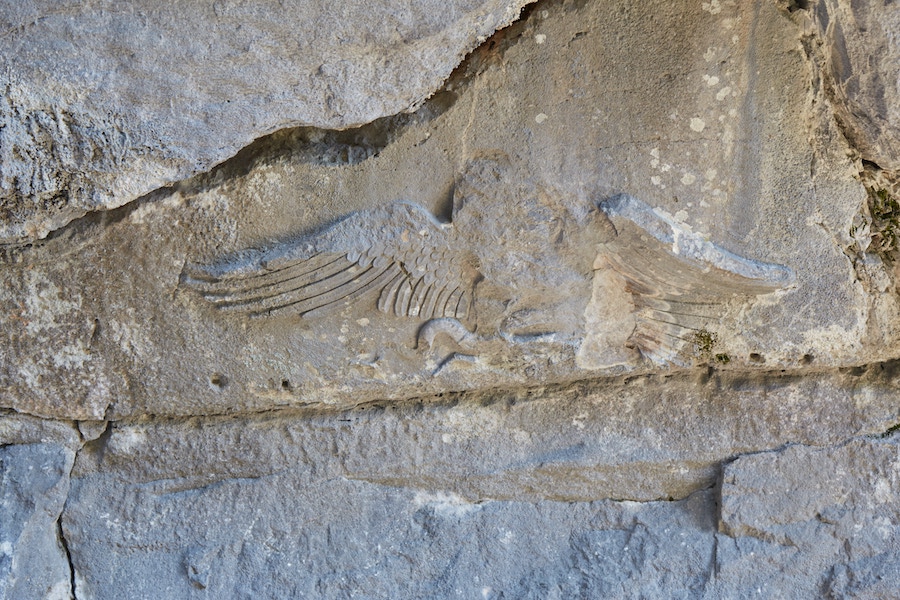

Antigonos then desecrated and abused the corpse of his rival for three whole days. He ultimately abandoned the body, leaving it unburied.
According to the story, the Termessian youth, disgusted with the elders’ betrayal, decided to arrange an elaborate burial for Alcetas. While no inscription explicitly mentions Alcetas, this intricately carved tomb is widely believed to be his final resting place.
Notice the carvings of the man on his horse as well as the eagle.
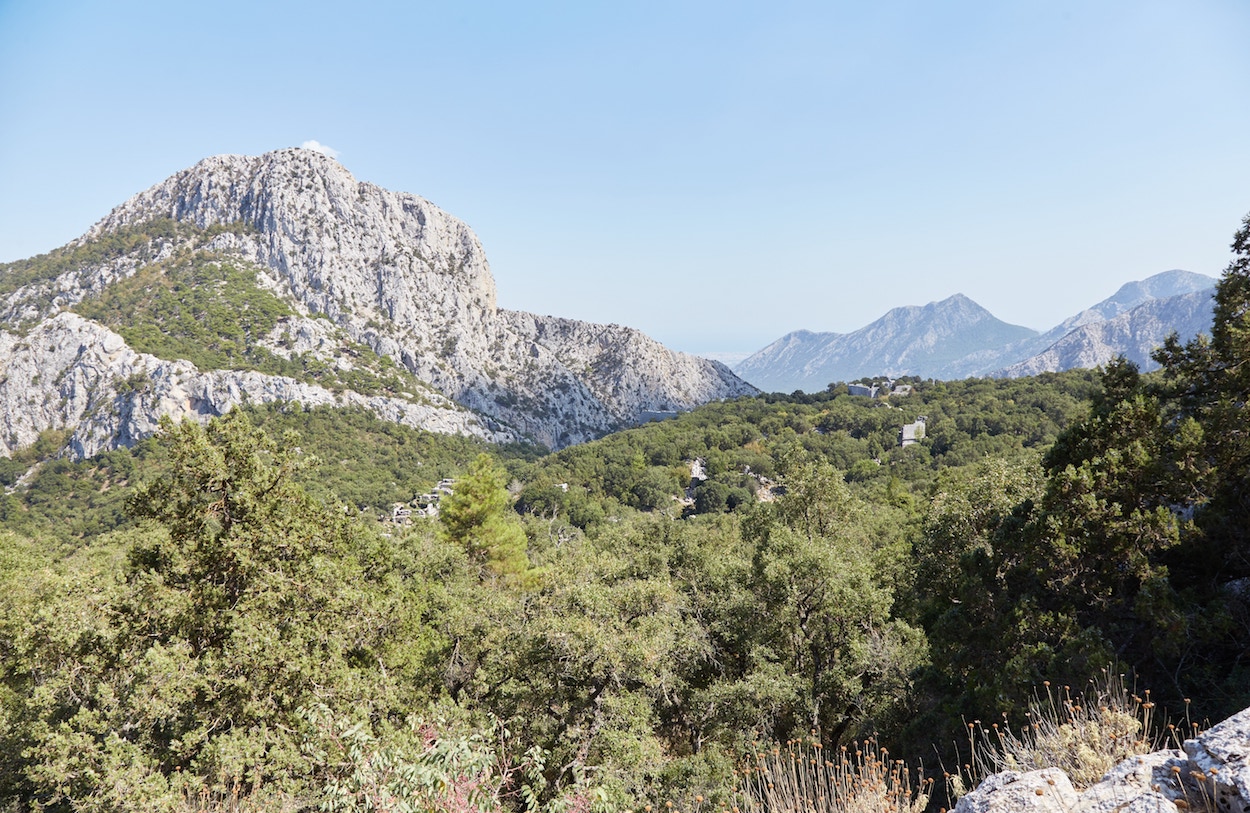
This area also offers nice views of the ruins down below. But the scenery from the next landmark is even better.
The Southwest Necropolis & Panorama Viewpoint
Coming back down the way you came from the Alcetas Tomb, you’ll find a sign pointing you to the Southwest Necropolis. And past the necropolis, the same trail leads to the highest accessible point of Termessos.

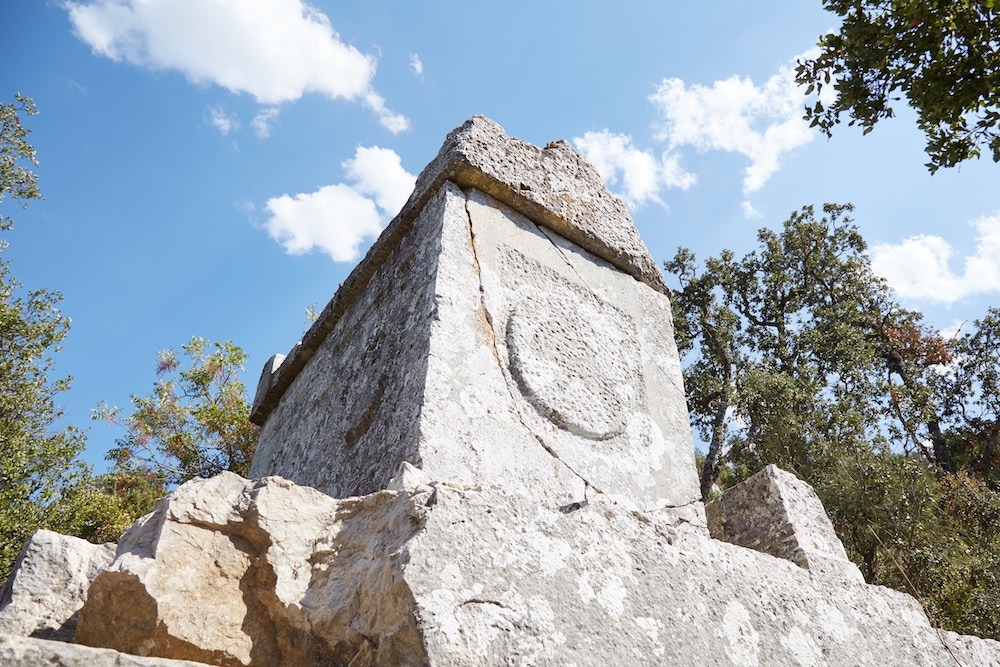

About halfway up, you’ll encounter a collection of some of the largest and most detailed sarcophagi in the area. Many of them would make fine additions to the Antalya Museum.
But here they’re just randomly scattered about the forest, as if they’d all accidentally spilled out of a massive jumbo jet.
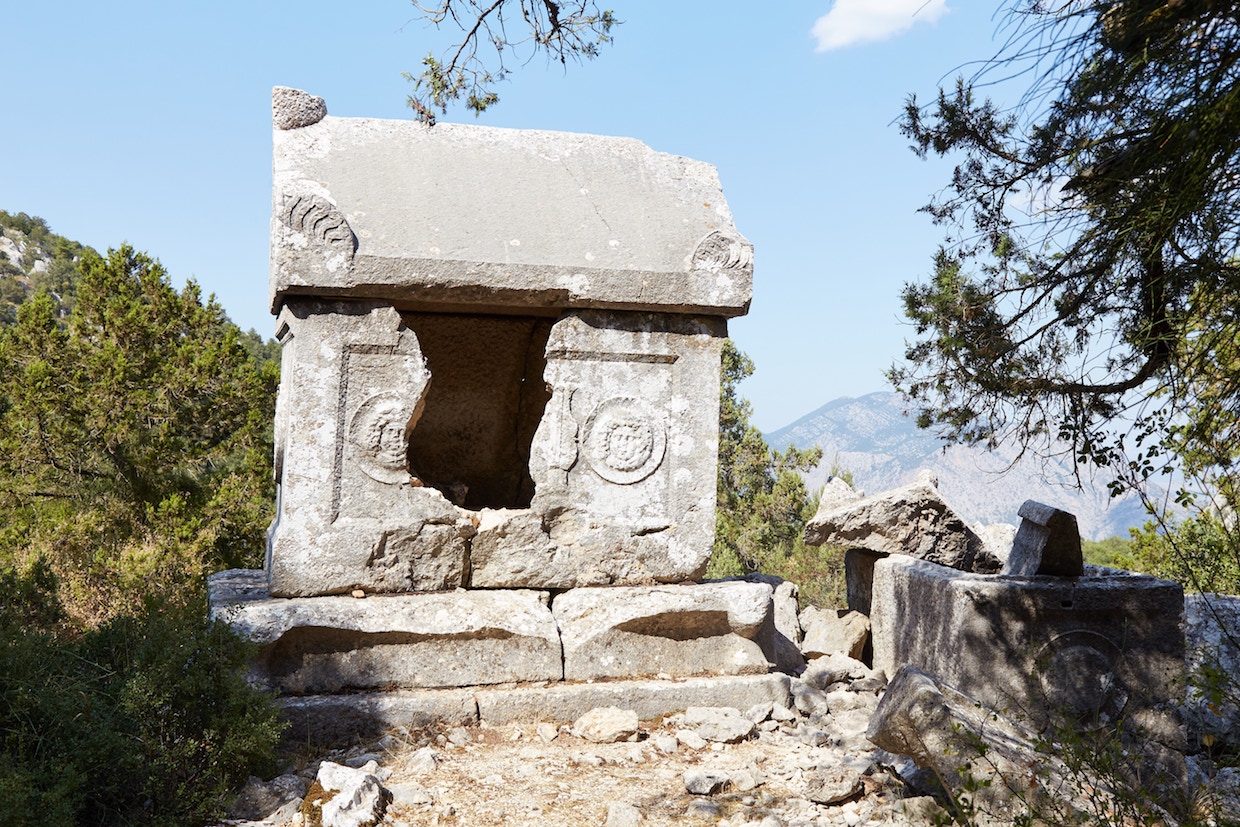
Continuing further uphill, you’ll keep passing broken sarcophagi just about everywhere you look. If you saved this section of Termessos for last like I did, you’ll likely find yourself getting quite tired. But don’t give up, as the climb is more than worth it.
The clear views from an altitude of over 1600 meters are breathtaking. Be sure to hang out at the top for awhile, taking in the scenery from all directions.
Unfortunately, there’s no place to buy water up here – or anywhere else in Termessos, for that matter – so be sure to bring plenty in advance.
When finished, come back the same way you came, and return to the center of the archaeological site.
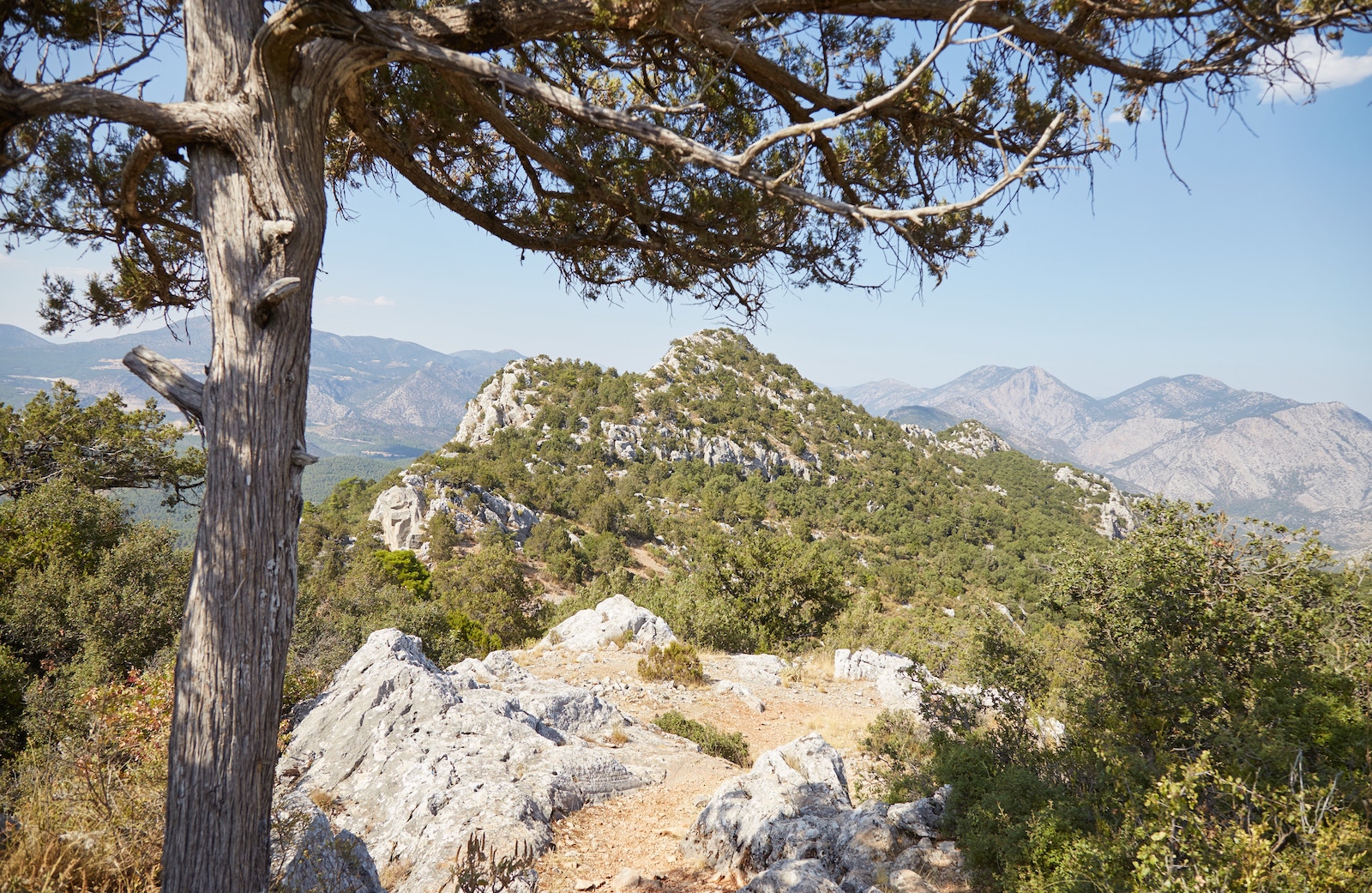

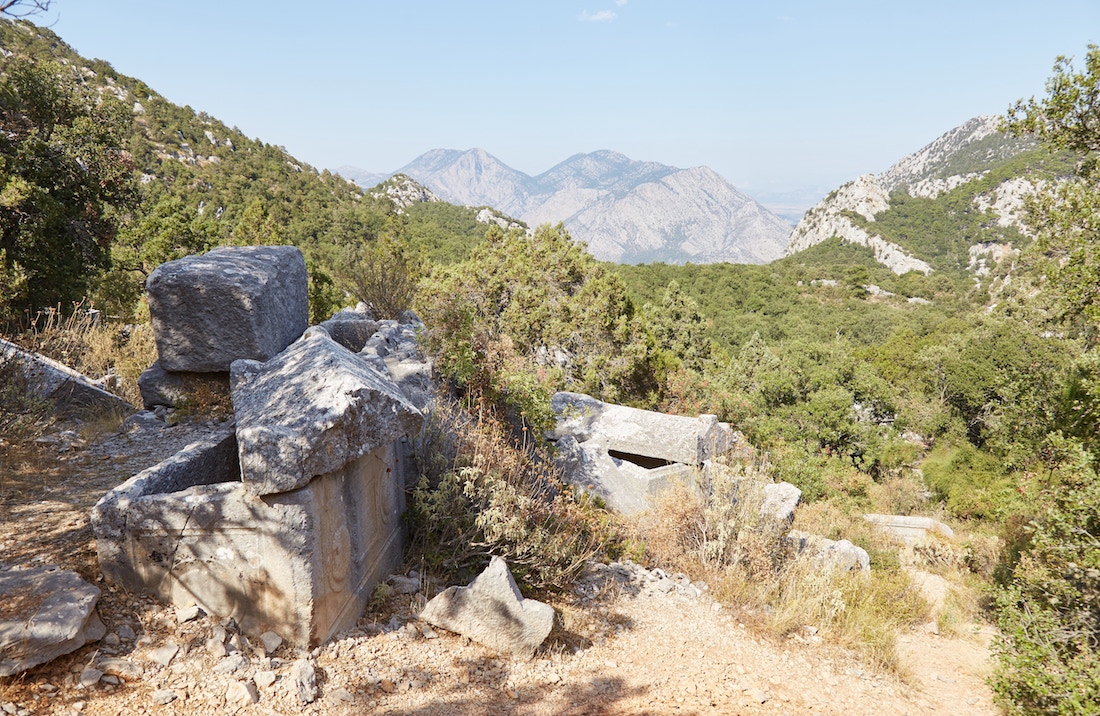
Exit via the Colonnaded Street
As mentioned above, there are two entrances/exits to central Termessos. And if you haven’t been there yet, now is the time to explore the former Colonnaded Street area. This area will ultimately lead you to an alternate path to the parking lot area.
Unlike at nearby Perge, none of the colonnades remain standing. The area is mostly a massive pile of old stones spread all over the grass. There are, however, a few intact structures nearby.
One of them, despite being very well-preserved, is yet to be identified by scholars. It’s now simply labelled as the ‘Unidentified Building.’
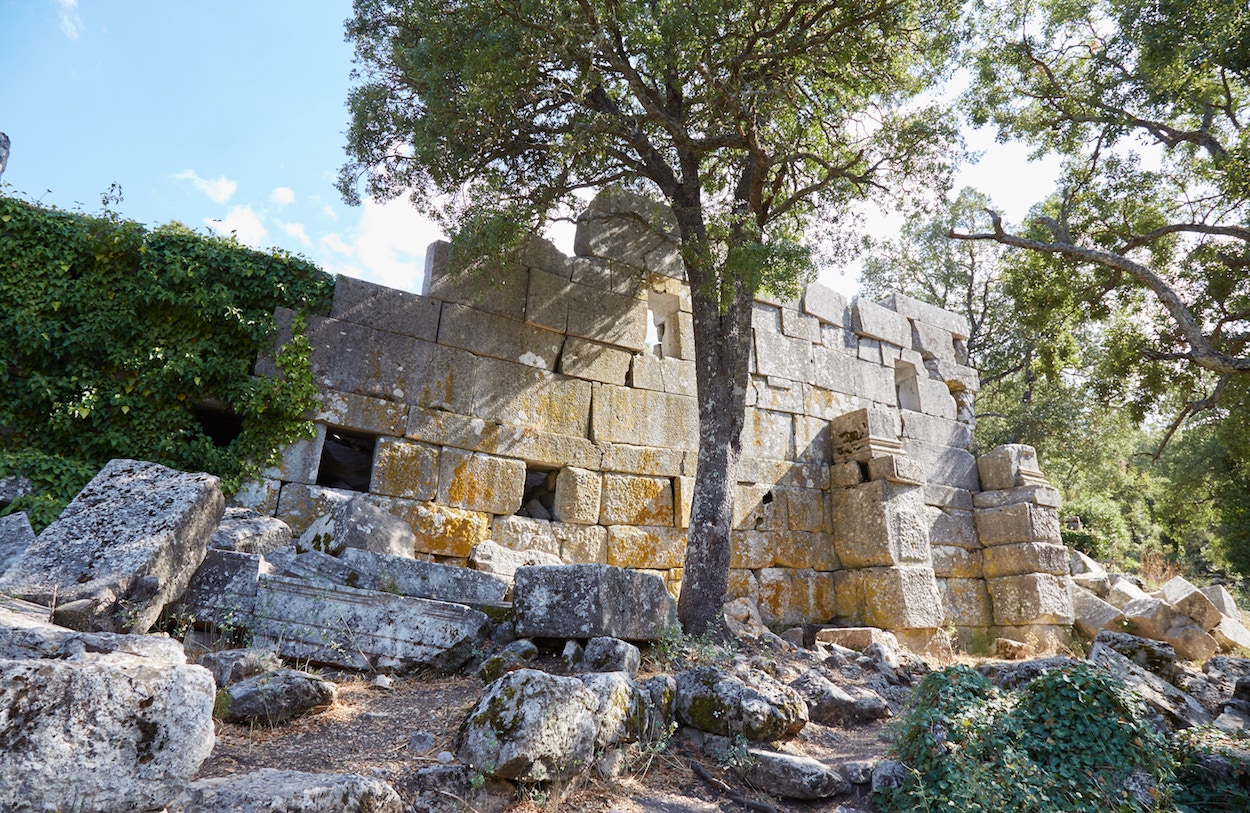
Elsewhere, you can also see some surviving fragments of the original aqueduct. In fact, it was the destruction of the aqueduct by an earthquake in the 5th century AD that directly resulted in Termessos’s abandonment.
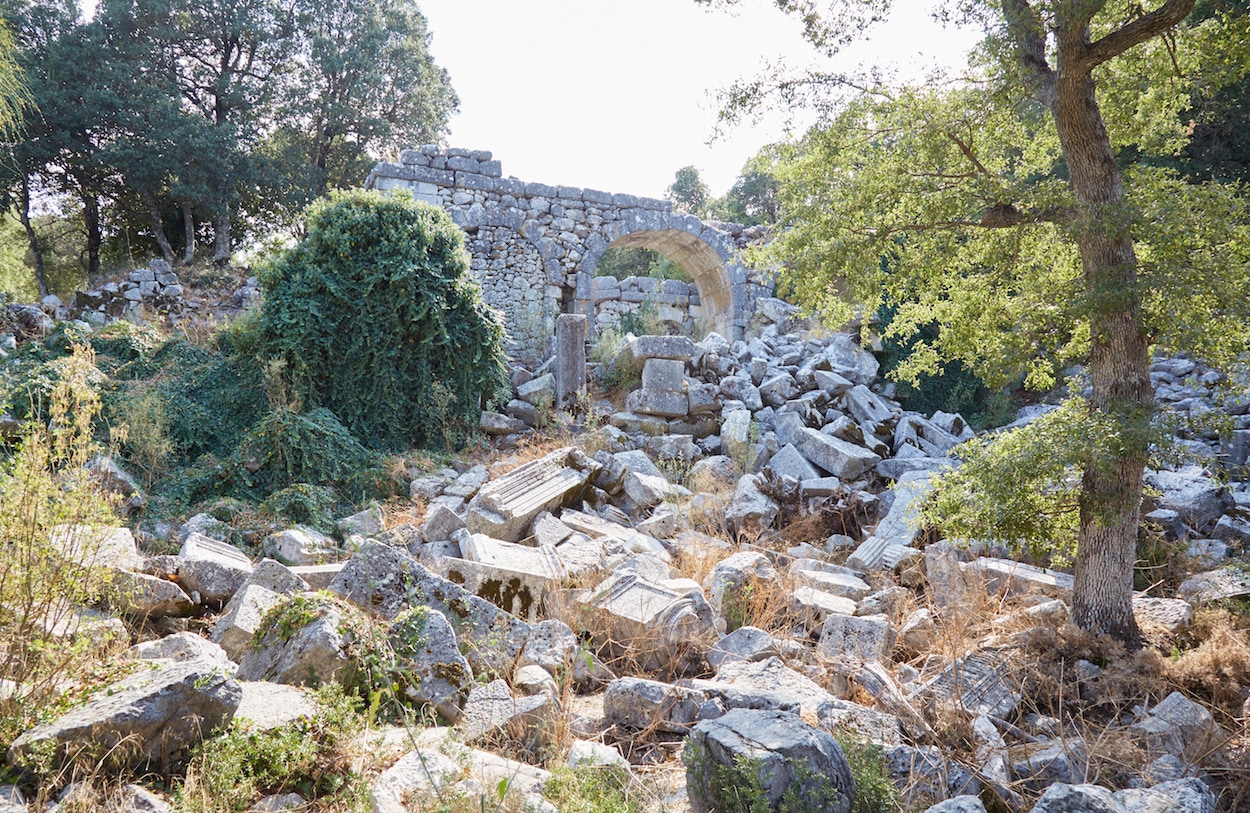
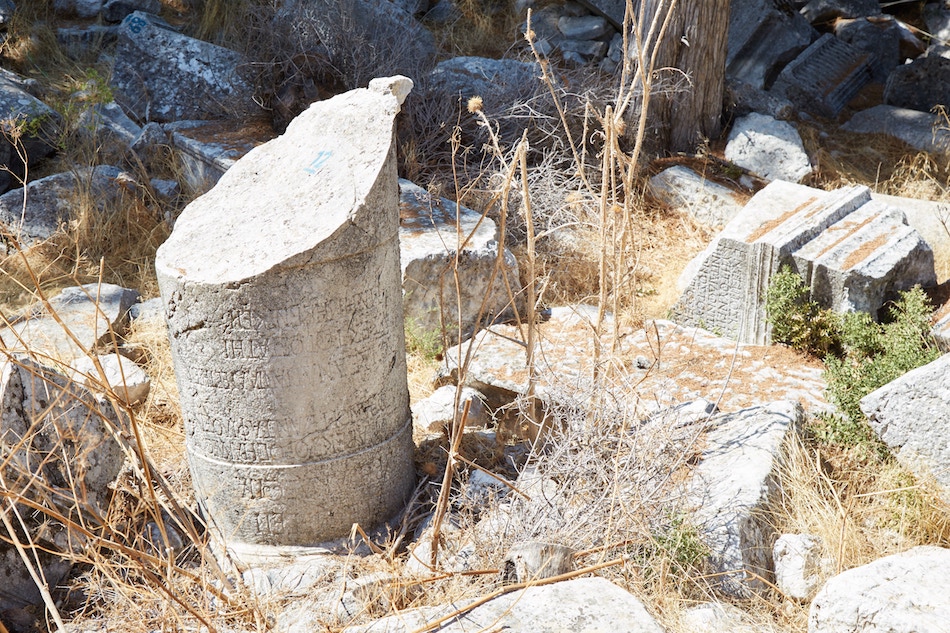
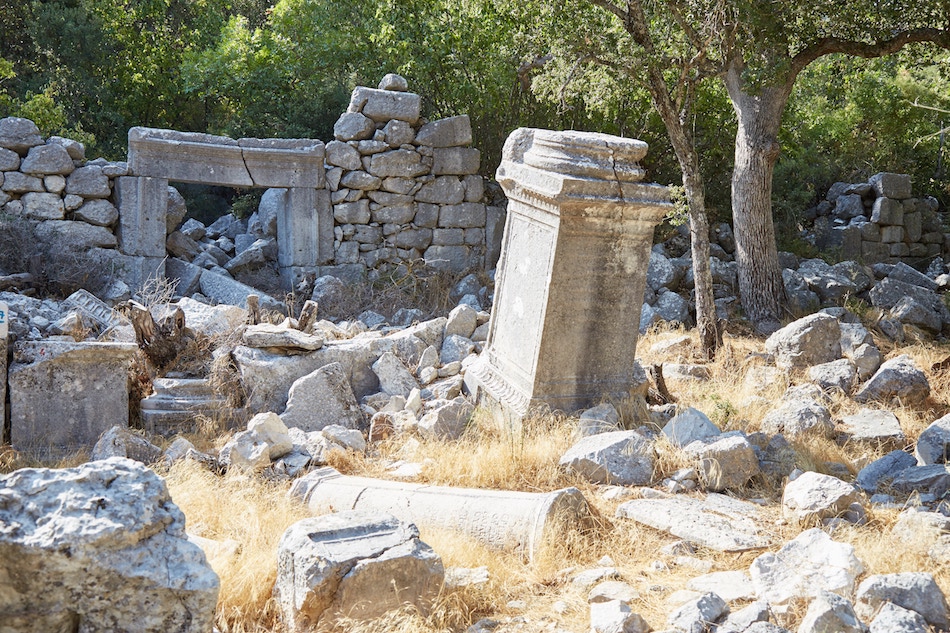
Walking through the ruins, continue heading in a northeast direction. You’ll eventually find yourself walking downhill – a route that will ultimately lead you to the exit
You’ll pass by things like the local travertine quarry, in addition to even more sarcophagi.
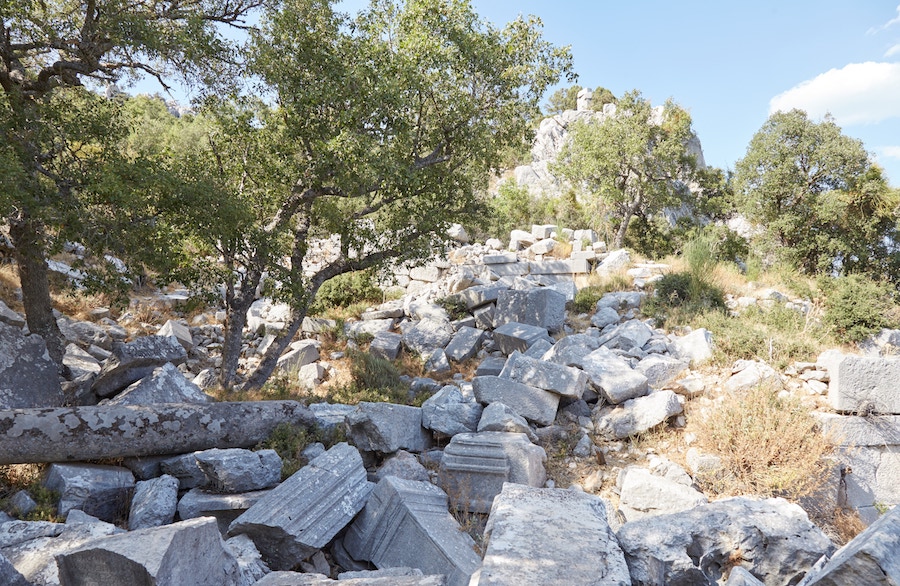

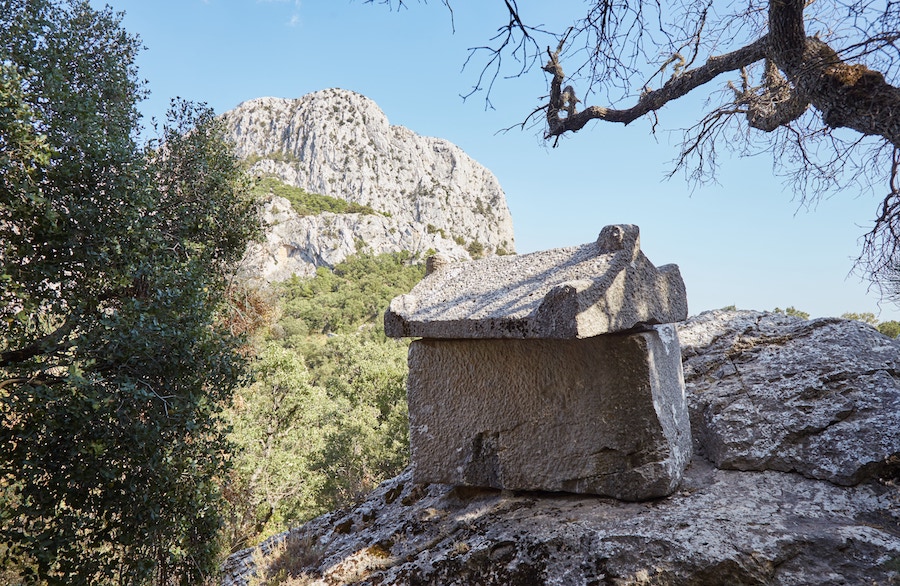
Also around here are some impressive rock-cut tombs. They were carved out along multiple levels of the mountain, much like the better-known tombs of neighboring Lycia.
Continue heading downhill, and you’ll finally come face to face with the lonely remaining gateway of Hadrian’s temple.

Back Down
There were no taxis waiting at the top, leaving me no choice but to walk back the 9 km. But that’s pretty much what I expected.
While the walk is, of course, entirely downhill, it was far from ideal after such a long day. And as the sun was getting lower in the sky, I wanted to make sure I made it back to the highway before sunset.
It was already 6 pm by the time I arrived. I was dying of thirst and utterly exhausted, but I didn’t expect much of an issue finding a ride back. After all, the man at the ticket booth assured me that morning that there would be plenty of buses running throughout the evening.
After a few minutes, a minibus with ‘Antalya’ on its window drove by, and I held out my arm. But it just kept on driving! I waited for the next one, and the same thing happened. And again with the next.
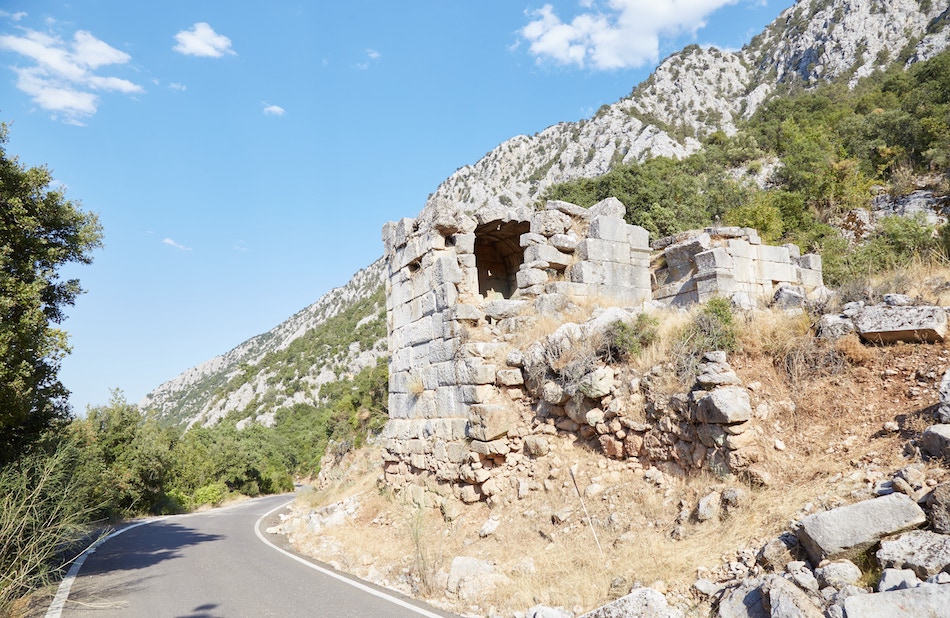

Apparently, none of these were regular minibuses, which typically pick up anyone no matter how full the vehicle might be. They all seemed to be part of some type of private transportation network.
It was about to get dark, and I had no choice but to hitchhike. And amazingly, the second I held out my thumb, the very first car to drive past me slowed down and stopped!
In the car were a pair of local girls, one of whom had studied in England and spoke great English. She dropped me off at the bus terminal, and I hopped on a tram to the city center. As rewarding as it was, my trip to Termessos was probably the most exhausting experience I had in Turkey.
Additional Info
From Antalya, you’ll first need to get to the otogar, or main bus terminal. This can easily be done via tram.
Note that the otogar has two sections – one for long-distance coach buses and another for regional buses. You’ll want to head to the regional one, or İlçeler Terminali.
You’ll find various buses lined up in the parking lot, with a detailed list of destinations in front. Tell the driver you want to go to Termessos.
I’m not sure if this particular bus departs on schedule, or only when full. In my case, it happened to be full when we departed at exactly 10:30 am.
Around 30 minutes later, the driver will drop you off along the highway at the nearest point to the ticket booth. At the time of my visit, a ticket cost no more than 10 TL!
As mentioned above, you will either need to negotiate with the taxi drivers or walk the 9 km to the site yourself.
While I did see a group of taxi drivers over to the side, I was surprised that they paid me no attention whatsoever. But I was feeling energetic at the time and decided to walk anyway.
In numerous online reviews, I read complaints about how unfair the taxi prices were, though I’m not sure what they typically cost. And if you take a taxi, you might also have to negotiate a time. Give yourself at least 3 hours in Termessos to see everything at a relaxed pace.
With that being said, I can’t exactly recommend people walk 9 km there and back, though you could try to hitchhike. If you’re traveling with a group, you might as well just split the costs for a taxi.
Given how cheap the ticket price is, it’s surprising they couldn’t organize a shuttle service for an additional fee, similar to Trabzon’s Sumela Monastery. But for better or for worse, Termessos remains a relatively obscure attraction.
Also as mentioned above, you may have trouble finding a minibus back to Antalya. But with Antalya being only around 17 km away, you shouldn’t have trouble hitchhiking.
Termessos isn’t quite like other archaeological sites in Turkey where you simply show up, explore, and then leave.
As mentioned, without your own transport, you’ll have to do A LOT of walking to the top and back. Additionally, even if you have a vehicle to get to the main parking area at the base of the ruins, Termessos is considerably rougher than most other tourist sites.
In addition to lots of uphill climbing, there’s a ton of overgrowth in some areas. And there are also many cases where you’ll be walking on uneven and slippery piles of rubble.
With all this in mind, be sure to bring decent shoes. While I did see some people in flip flops, you’ll thank yourself for putting on sturdy footwear.
Even if you’re visiting in summer, it would also be wise to wear long trousers to protect your legs from thorns.
Note that there are no places to buy water anywhere on-site, so be sure to bring enough. There is a public restroom by the parking lot area, but the tap water isn’t really meant for drinking.
As this will be a long day out, be sure to put on enough sunscreen or bring the container with you.
In regards to navigating the site itself, I recommend downloading the free app Maps.me. The landmarks are all clearly marked along with the individual trails needed to reach them.
Given its size and popularity among tourists, Antalya is one of Turkey’s easiest places to reach.
Antalya Airport is serviced by not just most other airports in Turkey, but plenty throughout Europe as well.
You will also easily find direct buses to Antalya from all over the country. Both long-distance coach buses in addition to smaller buses from nearby coastal cities are abundant.
The otogar (bus terminal) is quite a distance from the city center, but you can take a tram back and forth. Antalya has lots of machines situated throughout the city where you can easily charge your transport card.
The most popular place to stay is right within the Kaleiçi, or Old Town district. As mentioned above, this a pleasant district lined with historical buildings and is completely pedestrian friendly. It almost acts as a city within a city.
It does, however, feel very touristy. The restaurants and shops are mostly oriented toward international tourists rather than locals, and the prices reflect that.
I’m a budget traveler who prefers a private room with an attached bathroom. I chose a hotel called Ay Otel 2, located in central Antalya and just outside Kaleiçi. This gave me the best of both worlds. I had easy access to affordable, local-oriented restaurants and shops, while also being able to walk to Kaleiçi in a few minutes.
Best of all, it’s located within short walking distance of the tram stop which connects with the otogar (bus terminal). You can even take the tram all the way to Perge.
If you have more money to spend, there’s no shortage of high-end accommodation throughout the city. Aside from staying in or near Kaleiçi, you might want to consider staying close to the Antalya Museum/Konyaaltı Beach, or perhaps by the Düden Waterfall/Lara Beach.
Another good option would be staying near the otogar. The city of Antalya is a great base for day trips around Antalya Province. But by the end of my several-day stay, I’d grown tired of taking the tram over to the bus terminal and back almost daily. Were I to do it over again on the same budget, I’d choose somewhere within walking distance of the otogar.
While the Turkish government isn’t quite as extreme as China when it comes to online censorship, you’ll probably want a decent VPN before your visit.
I’ve tried out a couple of different companies and have found ExpressVPN to be the most reliable.
Booking.com is currently banned in the country (at least when you search for domestic accommodation). However, there are actually quite a few Turkish hotels listed on there anyway. And many them don’t even appear on Hotels.com, which hasn’t been banned.
Over the course of my trip, I ended up making quite a few reservations with Booking.com and was really glad I had a VPN to do so.
Another major site that’s banned is PayPal. If you want to access your account at all during your travels, a VPN is a must.
While those are the only two major sites that I noticed were banned during my trip, Turkey has even gone as far as banning Wikipedia and Twitter in the past.

Pin It!
